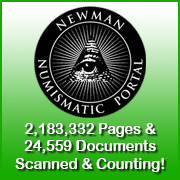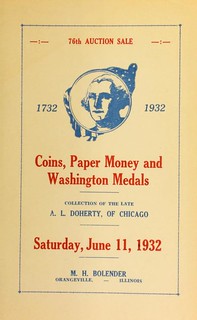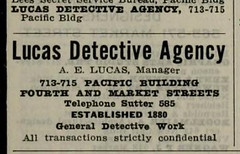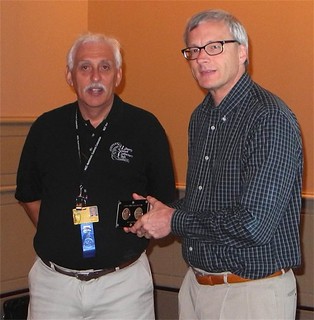
About UsThe Numismatic Bibliomania Society is a non-profit association devoted to the study and enjoyment of numismatic literature. For more information please see our web site at coinbooks.org SubscriptionsThose wishing to become new E-Sylum subscribers (or wishing to Unsubscribe) can go to the following web page link MembershipThere is a membership application available on the web site Membership Application To join, print the application and return it with your check to the address printed on the application. Print/Digital membership is $40 to addresses in the U.S., and $60 elsewhere. A digital-only membership is available for $25. For those without web access, write to: Terry White, Treasurer AsylumFor Asylum mailing address changes and other membership questions, contact Terry at this email address: terrywhite5475@yahoo.com SubmissionsTo submit items for publication in The E-Sylum, write to the Editor at this address: whomren@gmail.com BUY THE BOOK BEFORE THE COINSale Calendar
|
- WAYNE'S WORDS: THE E-SYLUM SEPTEMBER 2, 2018
- E-SYLUM ANNIVERSARY: 20 YEARS OF NUMISMATICS
- NBS WEB SITE WIKI UPDATE: THOMAS ELDER
- NEW BOOK: DATED COINS OF ANTIQUITY SUPPLEMENT
- REVIEW: CONFEDERATE NUMISMATICA SUPPLEMENT ONE
- COIN WORLD AVAILABLE IN NEWMAN PORTAL SEARCHES
- COINAGE ARTICLE HIGHLIGHTS HERITAGE WEB PLATFORM
- BRUNK MERCHANT COUNTERMARKS PUBLISHER SOUGHT
- NOTES FROM E-SYLUM READERS: SEPTEMBER 2, 2018
- MORE ON THE LUCAS SECRET SERVICE
- MORE ON BENJAMIN BUTLER FERROTYPES
- VOCABULARY TERM: LINEAR PERSPECTIVE
- JULIUS LEWIS BROWN (1848-1910)
- SELLING BREEN'S COMPLETE ENCYCLOPEDIA
- THE ANA'S MORITZ WORMSER MEMORIAL COLLECTION
- WILLIAM AND CHARLES BARBER EXHIBIT
- LIBERTY SEATED COLLECTORS CLUB AWARDS
- MINT SEEKS ARTISTIC INFUSION PROGRAM APPLICANTS
- 2019 AMERICAN LEGION COMMEMORATIVE COIN DESIGNS
- U.S. MINT AND BEP JOIN MARKETING FORCES
- THE 50 STATE QUARTERS PROGRAM
- MEDAL SELECTIONS FROM NUMISMAGRAM: SEPTEMBER 2018
- NUMISMATIC NUGGETS: SEPTEMBER 2, 2018
- MORMON MONEY IN KAGIN'S SEPTEMBER 2018 SALE
- EMPEROR NORTON BOND IN KAGIN'S SALE
- NORTHEAST SELLS 1943 COPPER CENT
- NEW EVERMAN COUNTERSTAMP DISCOVERED
- SAUDI BANKNOTES INSPIRED BY HAJJ PILGRIMAGE
- FORMER MEXICAN PRESIDENT ON NEW BANKNOTE
- WHY DOES THE DOLLAR BILL LOOK THAT WAY?
- LOOSE CHANGE: SEPTEMBER 2, 2018
- FEATURED WEB SITE: ELSEWHERE NUMISMATIC SOCIETY
Click here to access the complete archive
Click here to unsubscribe (scroll down)
To comment or submit articles, reply to whomren@gmail.com
Content presented in The E-Sylum is not necessarily researched or independently fact-checked, and views expressed do not necessarily represent those of the Numismatic Bibliomania Society.
WAYNE'S WORDS: THE E-SYLUM SEPTEMBER 2, 2018
 New subscribers this week include: Everitt Bowles, courtesy of Peter Bertram; Lee McKenzie, courtesy of Allan Schein; Allan Bogutz, and William Bell Davenport. Welcome
aboard! We now have 5,786 subscribers.
New subscribers this week include: Everitt Bowles, courtesy of Peter Bertram; Lee McKenzie, courtesy of Allan Schein; Allan Bogutz, and William Bell Davenport. Welcome
aboard! We now have 5,786 subscribers.
Thank you for reading The E-Sylum. If you enjoy it, please send me the email addresses of friends you think may enjoy it as well and I'll send them a subscription (but let me know if they are located in the European Union). Contact me at whomren@gmail.com anytime regarding your subscription, or questions, comments or suggestions about our content.
This week we open with an anniversary - our own! The e-mail newsletter we now call The E-Sylum was inaugurated twenty years ago this week with a short message on the morning of Friday, September 4, 1998. Next up is an update to the NBS Wiki, a new book, a review, and an important addition to the Newman Numismatic Portal.
Other topics this week include the Brunk merchant countermarks book, Gen. Benjamin Butler numismatica, collector Julius Brown, the Moritz Wormser collection, the U.S. Mint, Mormon money, Emperor Norton, another 1943 copper cent, and why the dollar bill looks the way it does.
To learn more about Thomas Elder auction sale catalogs, the dated coins of antiquity, Confederate Numismatica, Washington medals, yard sale finds, perspective on coins and medals, Mnit engravers William and Charles Barber, the 50 state quarters program, Salvador Dali medals, and banknote inspired by the Hajj, read on. Have a great week, everyone!
Wayne Homren
Editor, The E-Sylum
E-SYLUM ANNIVERSARY: 20 YEARS OF NUMISMATICS

The publication you're reading was inaugurated twenty years ago this week with a short message on the morning of Friday, September 4, 1998. Created initially as a newsletter to connect members of the Numismatic Bibliomania Society, it has been free and open to all from day one, and grown to a hefty weekly dose of all things numismatics. Thanks to all our readers whose contributions have made The E-Sylum a useful and enjoyable exchange of ideas and information in the world of numismatics.
We are now in our 21st year with 1,052 issues behind us totalling 25,089 individual articles and 28,171 images. The archive is fully searchable on the NBS web site and is also backed up as part of the Newman Numismatic Portal. -Editor
 To access and search the complete archive, see:
To access and search the complete archive, see:
The E-Sylum eNewsletter Archive (http://www.coinbooks.org/club_nbs_esylum.html)
To access the complete table of contents, see:
E-Sylum Contents - All issues (http://www.coinbooks.org/esylum_toc.html)
Most Popular Photos on Flickr

To view our Flickr photostream, see:
Numismatic Bibliomania Society (NBS) (https://www.flickr.com/photos/coinbooks/with/44427699501/)
THE BOOK BAZARRE
NBS WEB SITE WIKI UPDATE: THOMAS ELDER

Tom Wetter writes:
It has been a while since I've been able to provide an update on our Wiki and this one is a good one - it really shows the collaboration of NBS members. I am proud to say the we now have a complete collection of Thomas Elder sales documented.
There will be more regular updates coming over the winter, or 'Wiki-season' as I call it. If anyone has any ideas or requests for something they would like to see please send them in!
While the Newman Numismatic Portal holds a vast store of information today, NNP cannot be all things to all people - there will always be a place for other web sites providing information or details not as easily presented there. For example, NNP does not document the physical size and color of auction catalogs, nor does it record the number of individual lots. Tom has painstakingly compiled such bibliographic details on the NBS Wiki. Thanks! -Editor
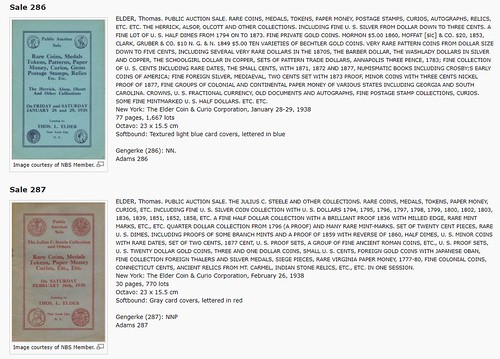
To visit the Elder page, see:
Thomas Elder Auction Sale Catalogues
(http://wiki.coinbooks.org/index.php/THOMAS_L._ELDER_AUCTION_SALES)
To visit all the Wiki auction listings, see:
Auction Sale Listings (http://wiki.coinbooks.org/index.php/Category:Auction_Sale_Listings)
To visit the Wiki main page, see:
Welcome to the Numismatic Bibliomania Society Wiki (http://wiki.coinbooks.org/index.php/Main_Page)
NEW BOOK: DATED COINS OF ANTIQUITY SUPPLEMENT
Edward Cohen submitted this announcement of the availability of a free download of a supplement to his book on the Dated Coins of Antiquity. Thanks! -Editor
Free download for RELEASE 2 of Dated Coins of Antiquity (DCA) - Tyre Supplement
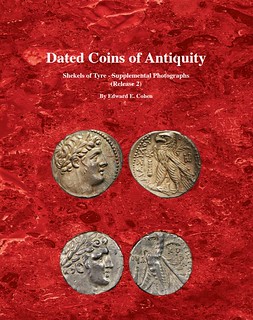 In 2017, Classical Numismatic Group (CNG) released and sold out of RELEASE 2 of Dated Coins of Antiquity - Tyre Supplement (DCA-Tyre). In its release
announcement, the author said that CNG would release a free digital download of the book after it sold out. The coverage is restricted to the shekels of Tyre and their smaller
denominations. It does not duplicate the material in the original volume, Dated Coins of Antiquity (DCA), which catalogs 6000+ coins dated before the millennium divide, 1
BC / AD 1.
In 2017, Classical Numismatic Group (CNG) released and sold out of RELEASE 2 of Dated Coins of Antiquity - Tyre Supplement (DCA-Tyre). In its release
announcement, the author said that CNG would release a free digital download of the book after it sold out. The coverage is restricted to the shekels of Tyre and their smaller
denominations. It does not duplicate the material in the original volume, Dated Coins of Antiquity (DCA), which catalogs 6000+ coins dated before the millennium divide, 1
BC / AD 1.
DCA-Tyre deals exclusively with the "shekel of Tyre" and its smaller denominations in silver. DCA contained 15 pages (pages 501 to 515) of rarity listings by date for the shekel of Tyre. The photo Supplement expands on the photos for this section of DCA. DCA-Tyre has a chapter for each denomination and date that the author has confirmed. Each chapter includes photos with an enlargement of each monogram and Phoenician letter (Aleph or Bet) for the date. For Release 2, there are nearly 1,000 photographs in all.
The full citation is "Dated Coins of Antiquity, Shekels of Tyre - Supplemental Photographs (Release 2)", by Edward E. Cohen
The complete Tyre supplement is available as a free digital PDF download at this web site: https://cngcoins.com/photos/cng_links/dca-tyre_release_2.pdf
For convenience, the book is also available for interactive viewing at issuu.com: Part 1: https://issuu.com/cngcoins/docs/dca-tyre_release_2-part_1
Part 2: https://issuu.com/cngcoins/docs/dca-tyre_release_2-part_2
The original Dated Coins of Antiquity (DCA) is available here: http://www.cngcoins.com/Coin.aspx?CoinID=190860 . DCA can also be purchased from Charles Davis or Forum Ancient Coins (United States), CGB Numismatics (France) or Paul-Francis Jacquier (Germany).
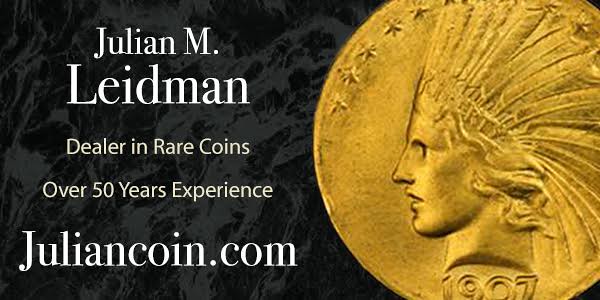
REVIEW: CONFEDERATE NUMISMATICA SUPPLEMENT ONE
Harold Levi submitted this review of Peter Bertram's new supplement to Confederate Numismatica. Thanks! -Editor
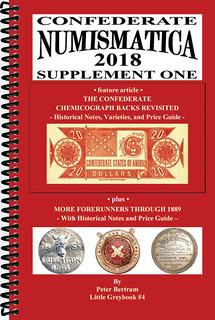
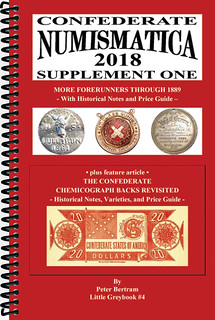
A review by Harold Levi
Peter Bertram has done it again! He has collected obscure information and compiled it into an excellent research and reference book. One of the problems with Confederate information is that at or near the end of the War many documents and physical objects were lost, stolen, burned, or otherwise destroyed. An additional problem is that some documents were bound into one-of-a-kind books, which were sold on the collector market and no one was permitted to first study the contents. Over the years, descendants of Confederate and Union soldiers have discovered Confederate items that had been hidden by a soldier and suddenly we have a revelation that changes the history we thought we knew.
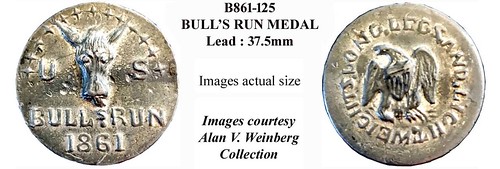
The first half of this book describes numerous ribbons, badges, tokens, and medals that Peter has located since publication of his first book. The various pieces are shown in full color, often in great detail. The images are universally clear and are important for identifying differences between similar items and recognizing fakes. There are folks out there who delight in making fake Confederate items in the interest of ill-gotten gains!
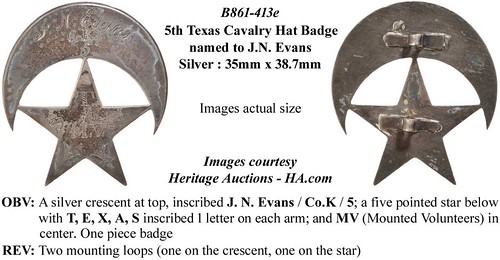
Peter shows the known varieties of a Confederate “A United South” token that was found at the Stone's River Battlefield near Murfreesboro, Tennessee. As can be seen on page 13, these tokens are a little rustic. George Corell, in his research of these pieces, found that an engraver and die sinker of some of these so-called Confederate dimes lived and worked in Murfreesboro. Interesting how things can tie together.
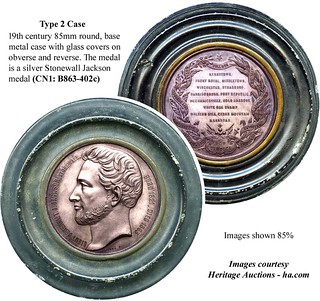 Mr. Bertram told the story of the Stonewall Jackson medals in his first book and now in his Supplement he shows some additional examples and two of the original cases.
One shipment of these commemorative pieces arrived in Richmond from Paris France in the Spring of 1865. A second shipment went to Savannah just as the War was ending and they were
stored in a warehouse and forgotten about. Some 30 years later, they were discovered by workmen cleaning up after a fire that destroyed the warehouse. The medals that were
salvaged were given to the United Daughters of the Confederacy (UDC) and sold for the benefit of disabled Confederate veterans.
Mr. Bertram told the story of the Stonewall Jackson medals in his first book and now in his Supplement he shows some additional examples and two of the original cases.
One shipment of these commemorative pieces arrived in Richmond from Paris France in the Spring of 1865. A second shipment went to Savannah just as the War was ending and they were
stored in a warehouse and forgotten about. Some 30 years later, they were discovered by workmen cleaning up after a fire that destroyed the warehouse. The medals that were
salvaged were given to the United Daughters of the Confederacy (UDC) and sold for the benefit of disabled Confederate veterans.
The second half of the book delves deeply into the Chemicograph backs for Confederate Treasury notes. If you thought most of what could be said about collecting them has already been written, please think again. Using auction catalogs from 1885 to 2017 and other obscure references, Peter has prepared the first ever catalog of the unused Chemicograph backs for the $500 to $5 Confederate 1864 Treasury notes. He has defined four separate printings (1879-80, 1883-84, 1948-49, and 1957-58) with color illustrations of all 38 known varieties, and listed them both individually and by sets. His two fully illustrated “Quick Reference” pages at the end summarize much of the book’s information and will be an invaluable tool to look up a Chemicograph note up in a hurry!
I was curious why Peter started each and every catalog listing with “B864-“. It seemed redundant to me so I asked him about it. He said
“…to keep all the Chemicograph listings together in the ‘Cumulative Index of Catalog Numbers’ (it starts on page 1). As more material is published I expect the Cumulative Index to be the simplest and quickest way to look up an item. If they wish to, collectors and dealers are free to drop the B864 prefix and just use the C numbers. For example B864-C175 is a First printing Set – but so long as ‘Chemicograph number’ is specified, so is C175.’”
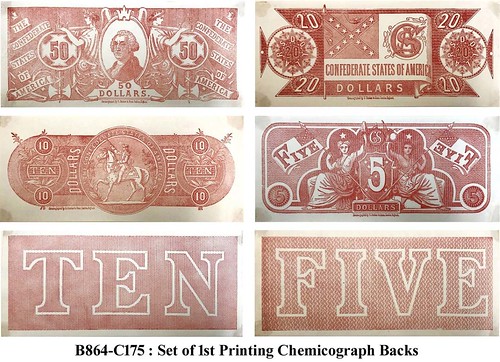
Mr. Bertram goes into great detail defining and describing the four printings and a lot of effort is expended making sure the reader understands how to identify the differences between them. In addition to his detailed descriptions, he presents images that perfectly illustrate the various issues he discusses. Collectors and students of the Chemicograph backs should come away with a detailed understanding of the subject.
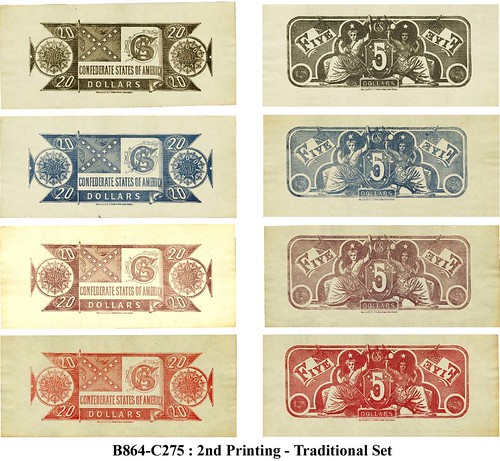
As the first ever cataloging effort of a subject about which so little is seemingly known, Peter presents us with a thoroughly researched and well written book. If you are a dealer, collector, or researcher of Confederate numismatic memorabilia, I highly recommend this work. Buy a copy – you’ll be glad you did!
I'll second that motion! -Editor
For more information, or to order, see:
https://confederatenumismatica.com/
To read the earlier E-Sylum article, see:
NEW BOOK: CONFEDERATE NUMISMATICA SUPPLEMENT ONE (http://www.coinbooks.org/v21/esylum_v21n32a05.html)
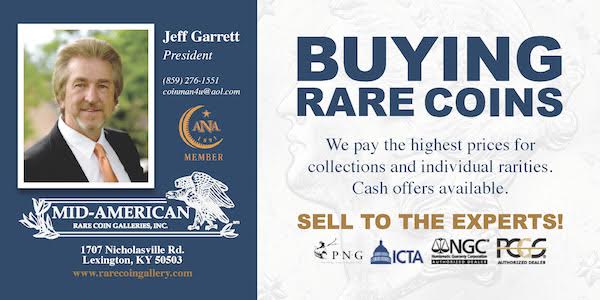
COIN WORLD AVAILABLE IN NEWMAN PORTAL SEARCHES
The latest addition to the Newman Numismatic Portal is Coin World. Project Coordinator Len Augsburger provided the following report. -Editor
Coin World Available on Newman Portal for Search-Only Access
The weekly messenger of the numismatic trade since 1960, Coin World represents a substantial store of numismatic information that is often lost to today’s researchers, who have no way of searching or accessing old issues. Complete runs of the periodical are few and far between, as the space required to store over 3,000 issues is considerable. Over the last year, Newman Portal has been scanning Coin World at various locations, and now announces the completion of the project.
Although not available for full view, this content can be searched by Newman Portal users. To search Coin World on Newman Portal, use the advanced search page and enter “periodical” as the content type and “Coin World” as the title. An NNP user this week located an extensive article on a numismatic theft from the Historical Society of Pennsylvania in the early 1970s, which was discoverable in no other way. Members of the American Numismatic Society (ANS) may acquire copies of specific articles through ANS librarian David Hill.

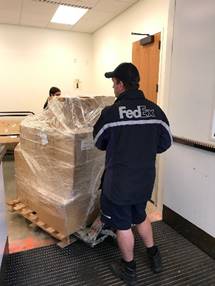
Coin World shipment and delivery to the
Internet Archive scanning center in Princeton, NJ.
Newman Portal acknowledges the ANS, which shared in the cost of digitization, and Beth Deisher and Ute Wartenberg Kagan for their support. Rick Amos at Amos Media provided the Coin World reference set from 1960-2005, while David Sundman of Littleton Coin Company loaned his run of Coin World from 2006-2017.
Link to advanced search page on Newman Portal:
https://nnp.wustl.edu/Library/AdvancedSearchForm
As a bibliomaniac I once had my own lengthy run of Coin World issues, yet it was impossible to use for reference without an index. I eventually sold it to Coin World for the cost of shipping - they used it to fill in a 2nd set that had been damaged in warehouse storage. My dream was always to see Coin World digitized one day. Former Coin World editor Beth Deisher and I had multiple long conversations about this including at the 2015 American Numismatic Association convention when I participated in a Numismatic Literary Guild Symposium panel discussion on "The Internet's Impact on Numismatic Journalism".
Many thanks to Beth, Amos Media, the ANS, fellow bibliomaniac David Sundman, and of course the Eric P. Newman Numismatic Education Society for making this a reality. The Newman Portal software now makes these 300,000+ pages of text searchable and findable. Many great gems of numismatic information and writing await researchers of today and tomorrow.
-Editor
ANS Executive Director Ute Wartenberg Kagan adds:
"I am so very grateful to Beth Deisher and the EPNNES for their extraordinary support, without which this rather elaborate project of scanning Coin World would have not been possible. I am not always sure that the numismatic community appreciates the cost, logistical issues and all sorts of other small problems that Len and his team encounter when they get publications up and running on the Newman Numismatic Portal. Adding Coin World was a Herculean labor, and I am so glad it got done after years of discussing it. Thank you everyone involved!"

COINAGE ARTICLE HIGHLIGHTS HERITAGE WEB PLATFORM
I just this week came across this, but COINage published an article May 3, 2018 about Heritage's online platform. Here's an excerpt; see the complete article online for more. -Editor
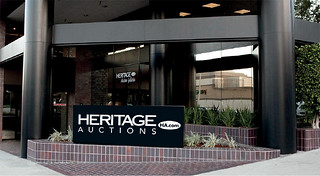 The booming coin market of the 1970s set the two as heated yet friendly rivals, whose businesses expanded from shops and shows to auctions. Halperin bought a mainframe
computer in 1975 and started an auction firm later that year. Ivy followed suit on both, and his first auction in 1976 drew $650,000 (roughly $2.8 million in today’s dollars).
“That’s a number we have surpassed over 100 times with single lots since then time,” Ivy said. “By 1979, we [Steve Ivy Rare Company] were the U.S.’s second-largest coin company
with 150 employees … but Jim [New England Rare Coin Galleries] was No. 1.”
The booming coin market of the 1970s set the two as heated yet friendly rivals, whose businesses expanded from shops and shows to auctions. Halperin bought a mainframe
computer in 1975 and started an auction firm later that year. Ivy followed suit on both, and his first auction in 1976 drew $650,000 (roughly $2.8 million in today’s dollars).
“That’s a number we have surpassed over 100 times with single lots since then time,” Ivy said. “By 1979, we [Steve Ivy Rare Company] were the U.S.’s second-largest coin company
with 150 employees … but Jim [New England Rare Coin Galleries] was No. 1.”
When the metals market crashed in the early 1980s, Ivy called Halperin with a proposition: Nothing could stop them if they combined the two companies and their individual talents. When the duo founded Heritage Galleries in 1982, competitors predicted the partnership would be lucky to last three years. Jim brought his best friend (and employee since 1975), Marc Emory, to Dallas with him to set up Heritage’s gold import business in Europe. Soon thereafter, Steve and Jim hired operations wizard Paul Minshull and coin expert Greg Rohan to help move the business forward. All five are still at Heritage. Marc, Greg, and Paul are now each part owners of the business, along with Todd Imhof, Cris Bierrenbach, Ryan Carroll, and Steve’s son, Chris Ivy.
“Our auction department was still behind several numismatic auction firms,” Ivy said. “Then, around 1995, everything changed. There was this new thing called ‘the internet.’”
The potential captivated Halperin, in particular: a connected world was tailor-made for the auction business. “Not only could Heritage reach clients around the world,” Halperin said, “but we could even the playing field for all buyers and sellers by making private information public.”
Between 1995 and 1999, the partners funneled resources to develop what would become HA.com. Heritage was the first auctioneer to combine traditional floor bidding with active internet bidding. The innovation catapulted the auction portion of the business to number one in that space, in commanding more than 50 percent of the market. “It was perhaps Jim’s best idea to build the website to make the entire auction process as transparent as reasonably possible,” Ivy said. “We listed all past lots and prices, which turned HA.com into the most-used resource in coins.”
To read the complete article, see:
Secrets of the Number One Online Coin Company
(http://coinagemag.com/secrets-of-the-number-one-online-coin-company/)
BRUNK MERCHANT COUNTERMARKS PUBLISHER SOUGHT
Greg Brunk is alive and kicking, and could use a publisher for the third edition of his book on merchant counterstamps. Bill Groom submitted this report. Thanks! -Editor
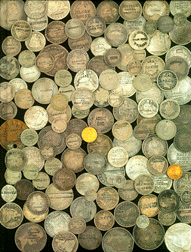 Last week, I spotted copy in an eBay listing, wherein a seller said he heard that Greg Brunk had died. I periodically talk with Greg, a longtime friend, by phone. As
I've long known that Greg has serious, ongoing health issues, and I'd not spoken with him in many weeks, I got a message to him. He phoned me two days later.
Last week, I spotted copy in an eBay listing, wherein a seller said he heard that Greg Brunk had died. I periodically talk with Greg, a longtime friend, by phone. As
I've long known that Greg has serious, ongoing health issues, and I'd not spoken with him in many weeks, I got a message to him. He phoned me two days later.
Greg laughed, saying that reports of his demise have been greatly exaggerated. He recalled that, twenty years ago, Russ Rulau had reported his, Greg's, demise in Numismatic News!
Naturally, I was elated to know that's Greg's still with us. The eBay seller apologized, saying he must have misheard what he thought he was told.
Sadly, Rich Hartzog passed, late last year. Rich was to publish the third edition of Greg's book on merchant counterstamps. Greg reports that the book is finished; this, but for insertion of the photographs on file. As Greg is legally blind, he's unable to accomplish this final task. His blindness is exacerbated by other health issues.
Greg approved my posting this info in The E-Sylum. He'd like to "see" his book, being many hundreds of pages in length, go to print. If there are any parties interested in this publishing project, I'll gladly put them in touch with Greg.
The Brunk book is THE Bible for the interesting and historically important series of merchant countermarked coins. I collected these for many years and we've discussed them often here in The E-Sylum - see the Everman counterstamp article and Bob Merchant's ad elsewhere in this very issue. Who would like to take on this project? Contact me and Bill and I will get you in touch with Greg. -Editor
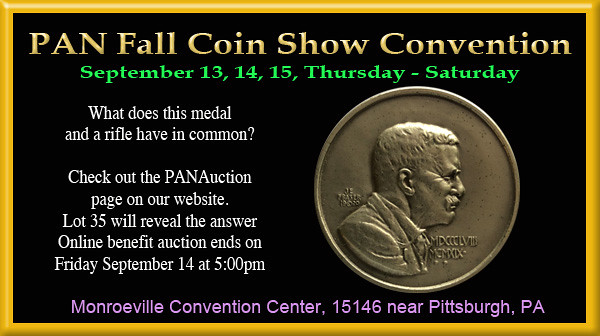
NOTES FROM E-SYLUM READERS: SEPTEMBER 2, 2018
More 2018 World's Fair of Money Exhbits
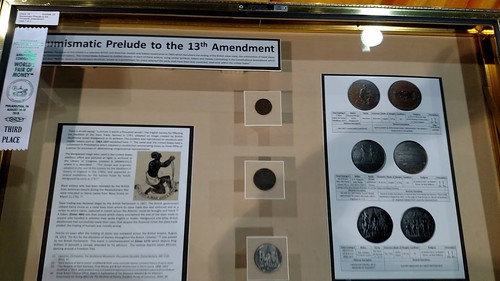
Ernie Nagy writes:
I really enjoy reading your numismatic compilation - it energizes me every week. Today I was happy to see you had noticed my exhibit "Numismatic Prelude to the 13th Amendment" and had included a picture of it on your FLIKR link- it made my morning!
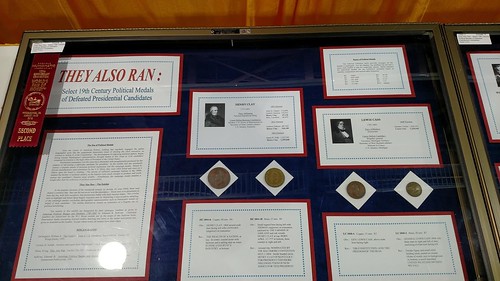
Bryce Doxzon writes:
I was surveying your photos of the exhibits at the recent ANA convention and was pleasantly surprised to see my exhibit (They Also Ran: Select 19th Century Political Medals of Defeated Presidential Candidates) among those you photographed. Thanks for the attention!
Nice exhibits. Glad to help publicize them! -Editor
To read the earlier E-Sylum article, see:
2018 WORLD'S FAIR OF MONEY EXHIBITS (http://www.coinbooks.org/v21/esylum_v21n34a24.html)
More on the Eagle Scout Medal
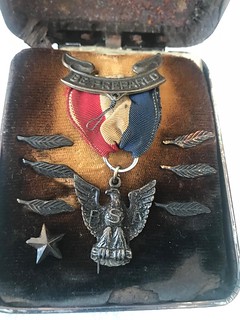 Regarding the Eagle Scout medal, Ken Berger writes:
Regarding the Eagle Scout medal, Ken Berger writes:
I never made Eagle Scout (in fact I didn't even come close). However, I'd like to know the meaning of the silver star contained with the medal.
George Cuhaj writes:
The star could be a local award for best patrol within a troop and worn near the patrol emblem. Or it could be a local activity award.
Early (pre-1945 ish) tenure was noted by a plain star (similar, but not of this design) with either green (1), purple (3), red (5) year felt circle back grounds).
Since the 1950s tenure stars have had a numeral at the center, raised, within an incuse blue enamel center circle, with plastic backgrounds for the year in each program (Tiger Cubs (orange), Cub Scouts (yellow), Boy Scouts (green), Exploring (red), Adult tenure (blue). They can work cumulatively or as one. So for example This year I celebrated my fiftieth year of registration. I could wear just one 50 star with a blue background, or I could wear a 3 with yellow, 7 with green, and 40 with blue.
Thanks! There's a lot for us non-scouts to learn. -Editor
To read the earlier E-Sylum article, see:
EAGLE SCOUT MEDAL OWNER SOUGHT (http://www.coinbooks.org/v21/esylum_v21n34a30.html)
Bolender 76th Sale Washington Medal Prices
Last week Mike Dlugosz asked about prices realized for Bolender's 76th auction held June 11, 1932. Two readers have come through with assistance. Thanks! I added an image of the sale cover from the Newman Numismatic Portal. -Editor
I'm looking for prices for three lots:
Lot 167 : baker 282. - Washington founder / A decisive...
Lot 303 : baker 620 - Washington bust / Soldier's tag
Lot 304 : baker 620-A - Washington bust / Emancipation
Dan Hamelberg writes:
Lot 167 - .15 (15 cents)
Lot 303 - .50 (50 cents)
Lot 304 - .90 (90 cents)
Looks like lot 304 gets the high honors. Big spender. Interestingly, the two most expensive lots in the sale were both numismatic literature lots. Lot 1158 was a set of the American Journal of Numismatics at $40, and lot 1159 was a set of Spink & Son's Numismatic Circular at $42. Good news for the numismatic literature market back in 1932!
Incidentally, there was a 1792 half disme in the sale (lot 1503) graded VF back then that sold for $38. Today, a complete set of AJN's would sell for much less than what a 1792 VF half disme would sell for. I guess turnabout is fair play.
Tom Wetter independently supplied prices which matched Dan's. Thanks, everyone. -Editor
To read the earlier E-Sylum article, see:
NOTES FROM E-SYLUM READERS: AUGUST 26, 2018 : Bolender 76th Sale PRL Sought
(http://www.coinbooks.org/v21/esylum_v21n34a10.html)
Money Stamp: Not to be Used for Buying Elections
Phil Iversen writes:
A few months ago I sent in some photos of political graffiti on currency and thought readers would enjoy seeing this new one.
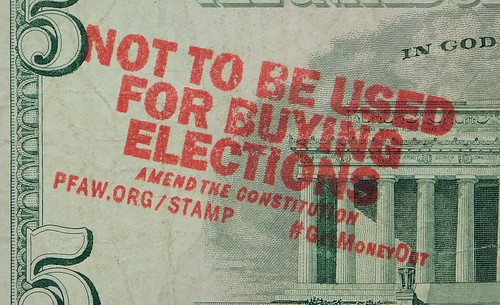
Cool - this is a new one to me. -Editor
To read the earlier E-Sylum article, see:
MORE ON POLITICAL SLOGANS ON BANKNOT (http://www.coinbooks.org/v21/esylum_v21n21a16.html)
Dave Hirt's Yard Sale Finds
Dave Hirt writes:
It has been my experience that it is rare to find numismatic items at yard sales, but this past weekend I made back to back finds of two neat, I think, items.
The first is a framed Russian Czarist bond, issued in 1911 for 22,500,000 rubles, numbered, and signed, and with four coupons attached. Also a stamp,(first word not completely legible) ETRANGERES GRATIS 1937 FRANCE.
The next is a commemorative plate issued by the Imperial Glass Corp. with the coinage of 1964 etched into it, titled Crystal Coins. It is in perfect condition in the original box, even in the original shipping box. It is interesting to me because of it being the last year of our silver coinage. Returning home with these finds, I was a happy camper.
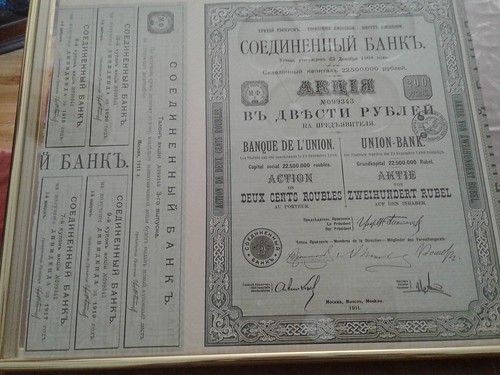
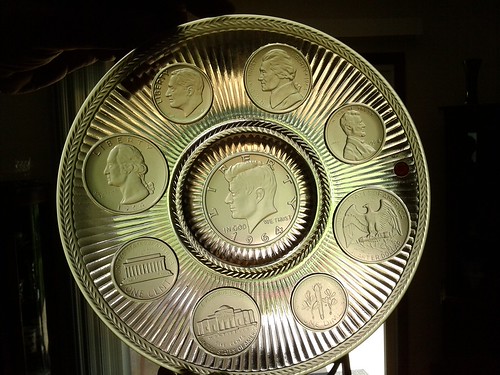
Both cool finds! -Editor
J.W. Scott Advertising Insert
David Pickup writes:
I bought a 1958 Seaby’s Standard Catalogue this week for £1.00. Inside was an advertisement for The J W Scott. Co L’d offering to identify coins starting at 10 cents.
Thanks. I don't believe I've seen this particular piece of numismatic ephemera before. Here are David's images. he also supplied the below link to John Lupia's web site. -Editor
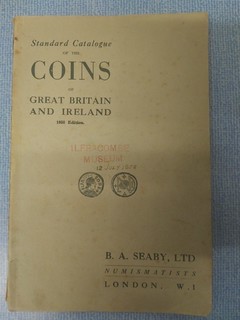
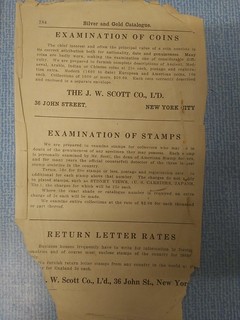
To read the earlier E-Sylum article, see:
SCOTT, JOHN WALTER (http://www.numismaticmall.com/numismaticmall-com/scott-john-walter)
Dansco Panama Album #7451 Sought
John Okerson writes:
If anyone has the Dansco Panama album #7451 (not the Panama Type, which is #7452), please contact me at johnokerson@gmail.com .
Can anyone help? -Editor
Notes on Tokens
Duane Feisel writes:
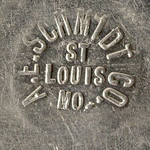 In regard to the Rand Dist. Fire Company token you noted: "Interesting St. Louis item."
In regard to the Rand Dist. Fire Company token you noted: "Interesting St. Louis item."
The only relation to St. Louis is that the token manufacturer was located there. This is a California token from Randsburg, Kern County. This is a fairly common token.
Then there is the Rio Cosumnes Correction Center token. This is a very common token – I know I have at least six or eight of them stuck away somewhere around here. And all are in at least AU condition – the piece pictured is in quite poor condition. And there is a catalog of prison tokens: Prison Token and Medals of the United States, Jerry Zara (1992).
Thanks. Zara's book seems to the the most recent on this topic, although reader Bob Hewey was considering compiling an update. Earlier research had been done by Jack F. Burns of Pittsburgh. Duane and I share Pittsburgh roots, although I came along to the numismatic scene afterwards. -Editor
Duane adds:
I knew Jack Burns quite well. He was active at the Carnegie Museum at the same time I was doing work there every Saturday. My area of activity was attribution of Byzantine coins – I had a collection of them at the time.
While working at the Museum, someone brought in a batch of parking tokens from the Pittsburgh area. The curator of coins Bill Woodside asked if someone of us would find out more about them. I volunteered to do so, and that is what really got me started in tokens!
To read the earlier E-Sylum articles, see:
SELECTIONS FROM THE HOLABIRD 2018 NCTA SALE (http://www.coinbooks.org/v21/esylum_v21n34a17.html)
AN APPROACH FOR CATALOGUING PRISON SCRIP (http://www.coinbooks.org/esylum_v17n21a16.html)
Buffalo Nickel Word Jumble Answer

Remember the word jumble puzzle Loren Gatch and Bill Hyder submitted a couple weeks ago? Click here to see Bill's answer: Buffalo Nickel Word Jumble Answer (https://www.flickr.com/photos/coinbooks/43527085485/in/dateposted-public/) -Editor
To read the earlier E-Sylum article, see:
NOTES FROM E-SYLUM READERS: AUGUST 12, 2018 : Buffalo Nickel Word Jumble
(http://www.coinbooks.org/v21/esylum_v21n32a14.html)
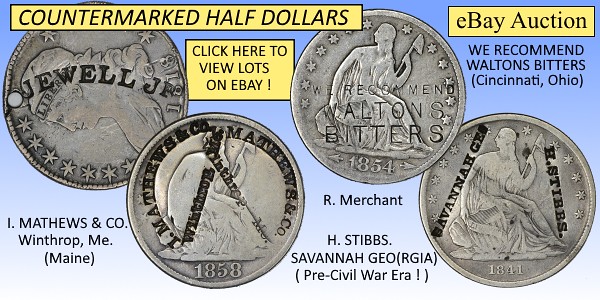
MORE ON THE LUCAS SECRET SERVICE
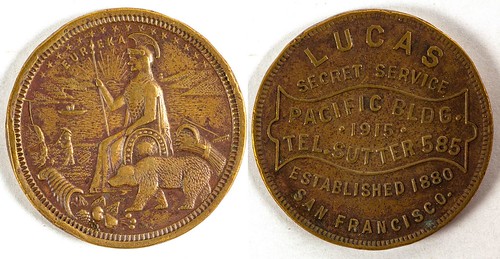
Last week I asked about the company that made this token offered in the Holabird NTCA auction, wondering if it was a private detective agency.
The Lucas agency was a private detective firm in San Francisco.
OK, it was a good guess I guess. Thanks for tracking down the ad. -Editor
Michael Wehner of San Francisco writes:
This token was indeed a private detective named Adelbert E. Lucas. The attached two clippings are from the 1915 San Francisco city business directory. This token is not all that rare - I have owned a few. But the very desirable and rarer Lucas token shows a bloodhound. There are a couple varieties with different addresses.
Thanks. I don't know how many private detectives issued tokens, but it sounds like a cool specialty to pursue (just like a detective)! Michael provided a link to the Token Catalog entry for the bloodhound token. Nice piece.
As it turns out, Michael was seated next to me at Bob Evans' talk at the World's Fair of Money in Philadelphia, but we didn't get a chance to meet. Sorry I had to rush in and out! -Editor

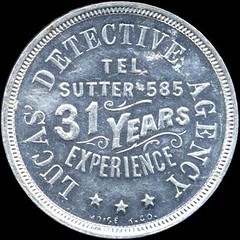
LUCAS' DETECTIVE AGENCY / TEL. / SUTTER 585 / 31 YEARS / EXPERIENCE / MOISE K. CO.
A.E. LUCAS / (bloodhound) / PACIFIC BUILDING, S.F., CAL.
TC-221309; K-1478 *** Albert E. Lucas, opened in 1880, token issued in 1911
To read the complete token listing, see:
San
Francisco, California (San Francisco County), U.S.A. (https://tokencatalog.com/token_record_forms.php?
action=DisplayTokenRecord&td_id=221309&inventory_id=223750
&td_image_id=122907&attribution_id=224903&record_offset=7)
To read the earlier E-Sylum article, see:
SELECTIONS FROM THE HOLABIRD 2018 NCTA SALE : Lot 195: Lucas Secret Service Token
(http://www.coinbooks.org/v21/esylum_v21n34a17.html)
MORE ON BENJAMIN BUTLER FERROTYPES
Alan V. Weinberg submitted these thoughts on Gen. Benjamin Butler ferrotypes. Thanks. -Editor
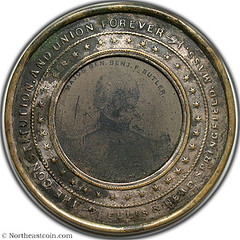
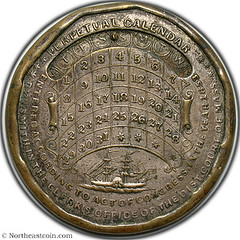
The segment concerning the possibly unique Benjamin Butler ferrotype / calendar medallet intrigued me.
The Matthew Brady clean-shaven so-called "Cooper Union" ferrotype image of Abraham Lincoln / calendar medallet (the catalogue cover plate) circa 1860 campaign sold for an astonishing $38.5K in the Sotheby's June 1999 Captain Andrew Zabriskie auction, a high water mark for Lincolnia. Today, it might bring $25K. It has interestingly not re-surfaced since then.
John Ford's Stack's 2013 part XXIV auction had both a Grant and a Grant / Colfax 1868 campaign ferrotype set in a calendar medallet, ex- Raymond-Boyd. They sold for several $1,000's apiece and were slightly imperfect, per my in-hand examination.
At this August's biannual national APIC in Springfield Illinois, I acquired a possibly unique Benjamin Butler "shellcard" ferrotype, virtually pristine, with a NY merchant advertisement on the reverse. This is only the 2nd Butler ferrotype I'm aware of now. Cost me $1,000 and I immediately turned down $2K. While typing this, I was surprised to find it was lot 10969 in the above Ford sale where I annotated its condition as "Wow!" and it sold for $881. There was so much in that once-in-a-lifetime sale that one could not buy everything of appeal.
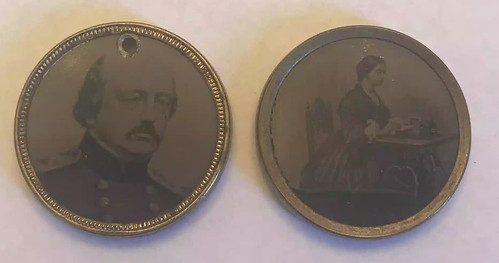
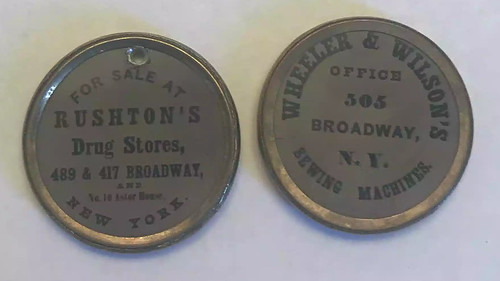
Tom Caldwell adds:
A good example of how the viewing power of your e-newsletter is a great research tool bringing out other like items to the public.
To read the earlier E-Sylum article, see:
ELLIS AND READ PERPETUAL CALENDAR MEDALS (http://www.coinbooks.org/v21/esylum_v21n34a12.html)

VOCABULARY TERM: LINEAR PERSPECTIVE
Dick Johnson submitted this entry from his Encyclopedia of Coin and Medal Terminology. Thanks. -Editor

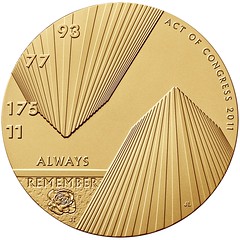
LEFT: Weiner's Cathedral medals (interior views) are an example of Perspective.
RIGHT: Designer Joel Iskowitz's Fallen Heroes medal is an example of Vaulted Perspective.
Linear Perspective. A view of a scene, person or object that is at eye level and true in proportions as if a photographic print. Linear
perspective will exhibit several optical effects including foreshortening and vanishing point in its realistic rendition. It is the most commonly used
perspective for coin and medal designs with a straight on, frontal view as if a person sights down his arm pointed toward the subject. The scene or view is such that the image is
that which would appear on a picture window pane between the viewer and the object. This is also called a picture plane. Linear perspective on coin and medal designs
are expressed as the frontal view, the full face portrait, the facade of a building, or the principle view of an object. In cataloging, linear perspective is considered the
normal, all other forms of perspective should be identified. See PERSPECTIVE.
CLASS 02.12
Perspective. How the spatial relationships of a three-dimensional scene or object is expressed on a coin or medal design. This includes the line of sight, the angle or view of vision, and the illusion of depth. Most coin and medal designs are created in LINEAR PERSPECTIVE, a straight on, frontal, single view of the person, scene or object. Every designer must be very obvious in his choice of perspective, as this will influence his design more than any technique or treatment other than the choice of his subject. Any design other than this front view, eye level design is called a “change of perspective,” some of which have formal names listed below, others are merely views from a different angle.
While the linear perspective is the standard, customary view – particularly for coin designs – medallic designs are not as restrictive. Medal designers have added interest with a variety of perspectives by changing the line of sight or the viewer’s eye position. (In this regard the “change of perspective” can be compared to a camera which can be raised or lowered, or moved around for a different angle, or to move in closer, or to back away for a greater field of view.)
Several problems exist in coin and medal design. First, of course, is the extremely small size. For the artist this is a very small canvas to prepare his design. Second is the raised relief of the design, where everything must be expressed in such low relief (often a few thousandths of an inch). The use of any perspectives within these design constrains are the numismatic and medallic artist’s most exacting design problems (and his greatest challenge!).
• Linear perspective. While standing, point your arm toward a scene or object (line of sight). What you see sighting down your arm is linear perspective. Should you photograph that scene or object, the image on the photo print would be a linear perspective. Another example is that of a scene or object viewed through a picture window. Linear perspective is that image that would appear on the window pane. This is also called picture plane.
The artist who chooses to do a mirror image of reality design must use this obvious perspective: face on, eye level, front view, what you see is what you get in the design. In numismatics this is expressed as the frontal view – the full face, the facade of a building or the principle side of an object, its picture plane.
Linear perspective utilizes several artistic techniques, these include: foreshortening – closer things look bigger, distant things are correspondingly smaller. Foreshortening is far more evident when the depth of field is greater, as in scenes. In portraits and most devices it is hardly evident because the depth of field is not that deep.
Linear perspective makes dramatic use of the vanishing point – things at such a great distance will be so small as to vanish, as the railroad tracks come to a point and vanish in the distance. The medals of Jacques Wiener are the most obvious of this kind of perspective.
Linear perspective also makes use of the ground line – which is often the BASE LINE – or a HORIZON line, although these may, or may not, be expressed in any numismatic or medallic design.
• Aerial perspective. An AERIAL VIEW is that as seen from above, as from an airplane, looking down usually on some small geographical area. It is also called BIRD’S EYE VIEW, as if seen from the eye of a bird. The technique can give a lot of meaning to a number of buildings and has been widely used for World’s Fairs since 1851.
Blueprints have a top view, the equivalent of aerial view; a side view, like linear perspective, and often a perspective view. While aerial view is a “map” of many features seen from above, the original concept of aerial perspective was identified and named by Leonard da Vinci. He also related it to the declining colors of distant objects. The opposite of aerial perspective is vaulted perspective.
• Vaulted perspective. Instead of looking down, as with aerial perspective vaulted perspective employs the line of sight looking skyward, looking upwards. Tall things like tall trees or buildings come together like the inside of a valulted ceiling. Dramatic medallic designs have been made of this perspective.
• Mixed perspective. Many views, each with its own different perspective, as an artistic arrangement of one medallic design, is known as mixed perspective. An example is the American Law Publishing Medal by Frank Eliscu.
• Other perspectives. Angular, parallel and panoramic perspectives are other tools of the designer, perhaps with limited application to coin and medal design. Conceivably, however, these perspectives could be employed by daring designers for perhaps some quite dramatic medallic art.
Position of the viewer’s eye. While linear is the normal, should the designer move in any direction to change the view, up or down, sideways, forward or backward, this is a change of perspective. Film directors have raised this technique to a fine art, as the camera angle changes often in motion pictures. This is done to add interest, highlight details and emphasize dramatic scenes. It keeps a film from becoming boring. It could do the same in medallic art when coin and medal designers occasionally change the perspective in their designs.
Creating an illusion of depth. Coin relief is about 1/32nd of an inch deep; medal relief can be higher, say as much as 3/8th of an inch. How can a designer indicate vast depth in these restrictive dimensions? The answer is in BAS-RELIEF. This sculptural technique enables the designer and modeler to give the perception of distance by extreme compression. A battle scene stretching for miles, for instance, can be shown on a coin or medal in bas-relief within these parameters. The inside of an immense cathedral can be shown on a 3-inch medal that includes exensive architectural detail (the Wiener medals illustrated herewith). Bas- relief gives designers this amazing sculptural ability once it is mastered.
Cataloging perspective. Any perspective other than linear should be identified when cataloging any coin or medal. Since linear perspective is considered the
normal, any other should be identified.
CLASS 02.12
Looking for the meaning of a numismatic word, or the description of a term? Try the Newman Numismatic Portal's Numismatic Dictionary at: https://nnp.wustl.edu/library/dictionary
Or if you would like a printed copy of the complete Encyclopedia, it is available. There are 1,854 terms, on 678 pages, in The Encyclopedia of Coin and Medal Technology. Even running two a week would require more than 19 years to publish them all. If you would like an advance draft of this vital reference work it may be obtained from the author for your check of $50 sent postpaid. Dick Johnson, 139 Thompson Drive, Torrington, CT 06790.

JULIUS LEWIS BROWN (1848-1910)
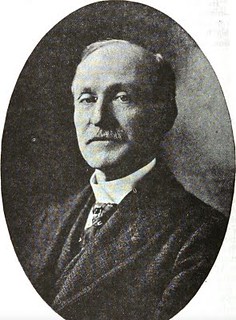 Julius Lewis Brown (1848-1910), was born on May 31, 1848, the eldest of eight children, son of Joseph Emerson Brown (1821-1894), Governor of Georgia, Chief Justice, and
U. S. Senator, and Elisabeth Grishom Brown (1826-1896), at Canton, Cherokee County, Georgia.
Julius Lewis Brown (1848-1910), was born on May 31, 1848, the eldest of eight children, son of Joseph Emerson Brown (1821-1894), Governor of Georgia, Chief Justice, and
U. S. Senator, and Elisabeth Grishom Brown (1826-1896), at Canton, Cherokee County, Georgia.
During the Civil War Julius turned down his father's offer to send him to Europe for his education choosing instead the Georgia State Military Academy. Brown and his brother cadets formed a militia to defend Athens. Brown was placed in charge of guarding Yankee prisoners. In 1864, he joined Company A and defended Atlanta. He fought with Wheeler's calvary and slowed down Sherman's advance to Savannah. He was part of the rear guard on the retreat from Savannah. Afterwards he went to Georgia Tech.
He graduated Harvard Law School in 1870. He worked as an attorney at Atlanta Georgia and was the attorney for Western & Atlanta Railroads (1870-1890), and as General Counsel for the State of Georgia co-incorporator of the Metropolitan Street Railroad.
As an initial investor with his father he became president of the Georgia Mining, Manufacturing and Investment Company. He also became president of the Walker Monument Association in the erection of the monument to Confederate Major General William Henry Talbot Walker (1816-1864), killed at the Battle of Atlanta.
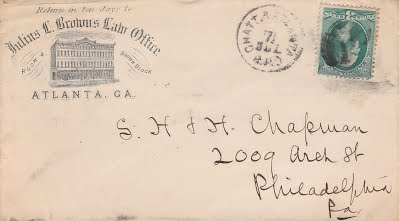
Brown began writing the Chapman Brothers in the first half of 1878 attested to by correspondence found in the Lupia Numismatic Library, Special Collection, The Chapman Family Correspondence Archive. He purchased many rarities from the Chapman Brothers including Proof Stellas, Bechtler gold pieces, colonials, 1776 Proof Pattern Pewter Continental Dollar, ancients - including a Philip II stater VF, 1795 UNC Eagle, 1795 UNC Silver Dollar, 1799 Cent VG, and European pieces. He also collected many rare Confederate notes and other collectible items.
From 1879-1881, he was a Corresponding Member of the ANS.
Since all his children predeceased him, in 1907, he appointed his brother Joseph MacKey Brown (1851-1932), of Marietta, Georgia, who served as Governor of the State of Georgia, as his executor, empowering him to sell his "library, autographs, coins, jewels, watches, miniatures, fans, porcelains, potteries, Indian relics, arms, paintings, engravings, ivories, glass, clocks, swords, bric-a-brac, &c., &c." to pay any outstanding debts due on his estate.
He died on September 4, 1910, at his home in Atlanta, Fulton County, Georgia. His funeral was held at the Second Baptist Church which was built by his father. The service was attended by his immediate family, brother Masons, Knight Templars, Confederate Army Veterans, Georgia Military Academy Cadets, distinguished members of the Atlanta Bar Association, and the illustrious citizens of Atlanta. He is buried in Oakland Cemetery, Fulton County, Georgia. Brown also served as president of the Mystic Owls.
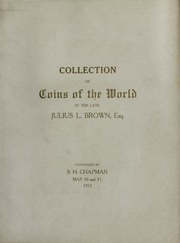 His coin collection was sold posthumously nearly nine months after his demise by order of his executor, his brother who was the Governor, Joseph MacKey Brown, through
Samuel Hudson Chapman.
His coin collection was sold posthumously nearly nine months after his demise by order of his executor, his brother who was the Governor, Joseph MacKey Brown, through
Samuel Hudson Chapman.
The Collection comprised 1242 lots. The catalogue was published with 7 plates in large format. A list of highlights of the sale together with prices realized were published in The Numismatist, June (1911) : 216
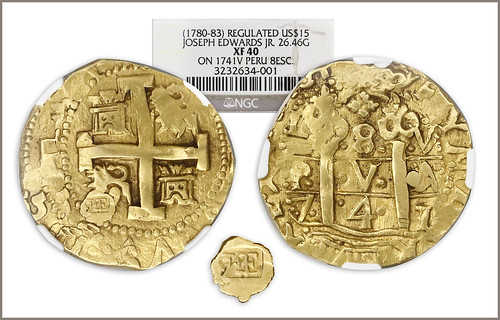
Lot 343 was a rare gold 8 escudos from the Lima, Peru Mint 1741, that was plugged and countermarked being regulated in 1780 by Joseph Edwards, Jr. (1737-1783), a goldsmith at Boston to $15.
Shortly following the Chapman sale another auction was held in Boston by Charles F. Libbie, on June 7-8, 1911, selling his library [Part 1] and medal collection [90 pages 1168 lots] (McKay 6999). A second Libbie sale followed on January 10-11, 1912, selling Mary B. Hathaway autograph collection Part III, together with the autograph collection of Julius L. Brown [98 pages, 1476 lots] (McKay 7062). Among his autographs are important correspondence regarding the Mexican war.
The Brown family papers are known as MS 785 in the University of Georgia archives.
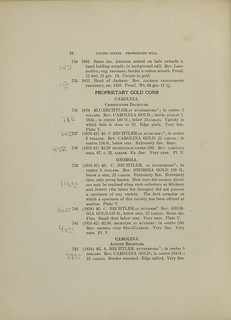
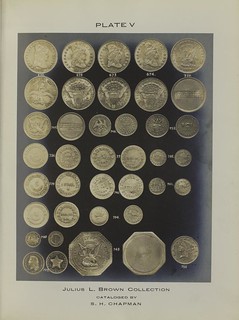
What a wonderful collection! The large format sale with seven plates can be viewed on the Newman Numismatic Portal. The article also discusses family infighting over the estate. The Brown family papers may prove useful to future researchers. The regulated gold piece was a featured item in the Sedwick May 2018 auction - see the earlier E-Sylum article linked below. -Editor
To read the complete article, see:
BROWN, JULIUS LEWIS
(https://sites.google.com/a/numismaticmall.com/www/numismaticmall-com/brown-julius-lewi)
To read the complete Chapman catalog, see:
CATALOG OF THE HISTORICAL COLLECTION OF GOLD, SILVER AND COPPER COINS OF ANCIENT GREECE AND ROME,
EUROPE, THE UNITED STATES, MEXICO AND SOUTH AMERICA, FORMED BY THE LATE JULIUS L. BROWN, ESQ., ATLANTA, GEORGIA. SOLD BY ORDER OF HIS EXECUTOR, HON. JOSEPH M. BROWN, GOVERNOR OF
GEORGIA. (https://nnp.wustl.edu/library/auctionlots?AucCoId=22&AuctionId=510992)
To read the earlier E-Sylum article, see:
SEDWICK MAY 2018 AUCTION HIGHLIGHTS (http://www.coinbooks.org/v21/esylum_v21n19a25.html)
The entire inventory of the Lupia Numismatic Library is for sale. Individual items will be available before the remaining archives are broken up into parcels sold at philatelic auctions in the U. S. and Hong Kong. Check NumismaticMall.com frequently as dozens of new items with estimates will be posted daily until everything is sold.
All inquiries will be given prompt and courteous attention. Write to: john@numismaticmall.com .

SELLING BREEN'S COMPLETE ENCYCLOPEDIA
P. Scott Rubin writes:
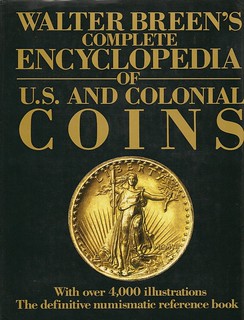 A few weeks back Dick Johnson wrote a piece about getting a signed copy of his Encyclopedia at a New Jersey show and how it was a bright Idea of Stanley
Apfelbaum's to do this. The fact is that Mark Auerbach was in touch with someone at Doubleday and with my help we invited Walter Breen to work with us in setting up a signing
session for his new book, at that time. The date the convention started was June 24th, 1988 and it took place in Cherry Hill, New Jersey.
A few weeks back Dick Johnson wrote a piece about getting a signed copy of his Encyclopedia at a New Jersey show and how it was a bright Idea of Stanley
Apfelbaum's to do this. The fact is that Mark Auerbach was in touch with someone at Doubleday and with my help we invited Walter Breen to work with us in setting up a signing
session for his new book, at that time. The date the convention started was June 24th, 1988 and it took place in Cherry Hill, New Jersey.
A large poster was created by Doubleday and was used at the show. Mark had Walter sign the poster and later sold it to Armand Champa. The books were shipped to my house in Lawrenceville, and kept in my garage until the day before the show when Walter came to my house and he signed a few copies dated June 23rd and marked signed in Lawrenceville.
The next day we put the boxes in my car and Walter and I drove to Cherry Hill where Mark met us and we set up a display just outside the door of the convention. Walter told me that this was the first time he had ever made any direct money for a sale of a book he had written. Since he worked for F.C.I., Apfelbaum's company his salary was his compensation for the book, and I took it to mean that anything he had written previously was under similar deals.
Thanks for the clarification! -Editor
To read the earlier E-Sylum article, see:
WALTER BREEN'S COMPLETE ENCYCLOPEDIA (http://www.coinbooks.org/v21/esylum_v21n32a07.html)
THE ANA'S MORITZ WORMSER MEMORIAL COLLECTION
An American Numismatic Association blog article published August 29, 2018 highlights the Moritz Wormser Memorial Collection. -Editor
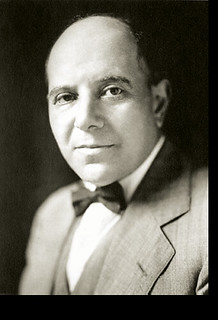 The ANA’s Edward C. Rochette Money Museum has one of the world’s most spectacular numismatic collections, including pieces from every country, time and genre. The
collection’s origins date to 1928, thanks in large part to the efforts of Moritz Wormser (1878-1940), one of the most prominent leaders in the Association’s history.
The ANA’s Edward C. Rochette Money Museum has one of the world’s most spectacular numismatic collections, including pieces from every country, time and genre. The
collection’s origins date to 1928, thanks in large part to the efforts of Moritz Wormser (1878-1940), one of the most prominent leaders in the Association’s history.
Born in Heidelberg, Germany, Wormser grew up in Wiesbaden, where he developed an interest in coins at age 12. After his parents died, he moved to the United States in 1898 to live with an uncle. He received degrees from Columbia University in 1899 and 1903, and Colorado College in 1900. Professionally, Wormser worked as an engineering contractor until 1911, then turned to finance until opening a coin shop in 1936.
Wormser had many collecting specialties, including silver thalers, portrait coins featuring notable women, and Asian rarities. He was able to recognize great specimens with a quick glance. One of the first Americans to specialize in world gold coinage, Wormser acquired a remarkable collection of rare Transylvanian gold and silver coins; his research on the subject was published in 1915. He was a Fellow of the American Numismatic Society and served as treasurer of the New York Numismatic Club.
In 1912 Wormser joined the ANA and five years later was elected to its Board of Governors. He was elected chairman of the Board in 1919 and in 1921 became ANA president. After four re-elections, Wormser stepped down in 1926 having served the longest term of any ANA president before or since, but remained on the Board for another decade. In the December 1923 issue of The Numismatist he suggested a weeklong celebration called Coin Week. In April 2018, the 95th annual National Coin Week was observed.
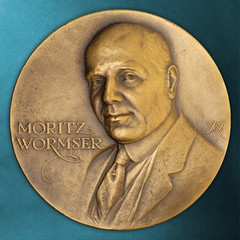 A permanent monument to the considerable legacy of this icon is the Moritz Wormser Memorial Collection, consisting of all objects amassed by the ANA until its permanent
headquarters was built in 1967. Wormser was longtime chairman of the ANA’s Coin Purchasing Committee, and arrangements were made between the Association and the Smithsonian
Institution for the storage and exhibition of loaned coins belonging to the ANA. In 1928 the Smithsonian received the first 63 specimens, with subsequent shipments continuing
periodically until 1966.
A permanent monument to the considerable legacy of this icon is the Moritz Wormser Memorial Collection, consisting of all objects amassed by the ANA until its permanent
headquarters was built in 1967. Wormser was longtime chairman of the ANA’s Coin Purchasing Committee, and arrangements were made between the Association and the Smithsonian
Institution for the storage and exhibition of loaned coins belonging to the ANA. In 1928 the Smithsonian received the first 63 specimens, with subsequent shipments continuing
periodically until 1966.
Upon Wormser’s death in 1940, fellow ANA Numismatic Hall of Famer David Bullowa became the Coin Purchasing Committee’s chairman. On December 21, 1940, Bullowa sent a letter to the Smithsonian stating that the ANA specimens in its possession would thereafter be referred to as the “Moritz Wormser Memorial Exhibit of the American Numismatic Association” (later renamed the Moritz Wormser Memorial Collection).
The collection consists of about 3,600 coins, medals and paper money from ancient to modern times. Because Wormser traveled extensively around the world, the collection is particularly strong in contemporary world coinage, especially from Europe, and includes objects acquired by committee members and donations from ANA members. It comprises some of the Association’s most interesting pieces, such as a 1933 eagle, a 1928 Chinese “Auto Dollar,” a 1934 Australian proof half penny and many world gold pieces. A 1928 German 3 reichsmark has the distinction of having Accession No. 1963.1.1—the first numerically identified object in the ANA’s vast holdings.
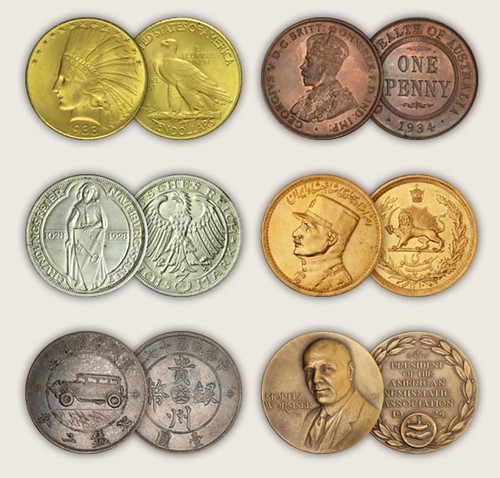
To read the complete article, see:
Tales From the Vault: The Moritz Wormser Memorial Collection (https://www.money.org/ana-blog/wormser)
THE BOOK BAZARRE
WILLIAM AND CHARLES BARBER EXHIBIT
An article by John Frost in the September 2018 issue of The E-Gobrecht (a publication of the Liberty Seated Collectors Club) highlights the wonderful exhibit at last month's American Numismatic Association show featuring artifacts of father-son U.S. Mint Chief Engravers William and Charles Barber. I greatly enjoyed the exhibit and this well-illustrated article is an excellent record of it. Follow the link to read the complete article online, with images of every case. -Editor
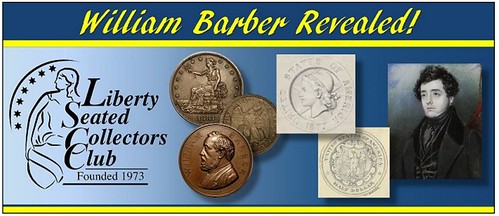
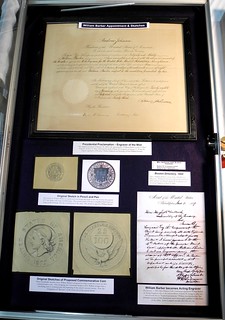 The groundbreaking exhibit on display at the LSCC table (and the BCCS table as well) was probably the most important on the entire floor of the recently held ANA World’s
Fair of Money. Thanks to the generosity of the Trepagnier family, the club exhibits presented historic artifacts of William and Charles Barber, the 5th and 6th Chief Engravers of
the U.S. Mint. William Barber designed the Liberty Seated Double Dime (twenty cents) and the Trade Dollar. The items on exhibit provided new insights into both engravers, and
changes much about what we know about them. The LSCC exhibit was entitled William Barber Revealed!
The groundbreaking exhibit on display at the LSCC table (and the BCCS table as well) was probably the most important on the entire floor of the recently held ANA World’s
Fair of Money. Thanks to the generosity of the Trepagnier family, the club exhibits presented historic artifacts of William and Charles Barber, the 5th and 6th Chief Engravers of
the U.S. Mint. William Barber designed the Liberty Seated Double Dime (twenty cents) and the Trade Dollar. The items on exhibit provided new insights into both engravers, and
changes much about what we know about them. The LSCC exhibit was entitled William Barber Revealed!
To make things even more memorable, one of William Barber’s great-great-grandsons, Pierre Trepagnier, and his wife Louise, came to Philadelphia for the ANA Convention. After they were introduced as special guests at the LSCC Annual Meeting, they adjourned with us upstairs to the bourse floor, where they were awestruck seeing their own artifacts on display with many others from Pierre’s brother, who was unable to attend.
A complete view and detailed description of each of the 12 cases of the William and Charles Barber exhibit is on the following pages of this issue of the E-Gobrecht, for your enjoyment in case you were unable to come to Philadelphia.
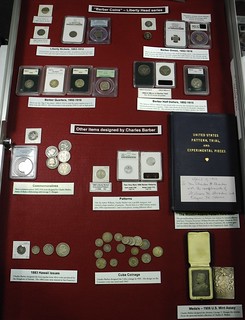
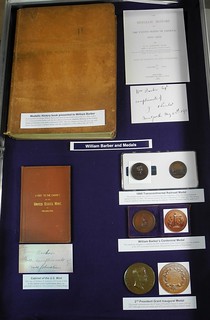
Cases 3 and 4
Numismatic bibliophiles will take note of items shown the photos.
Case 3: The 1913 Adams-Woodins pattern book, inscribed to Charles by Woodin on April 3, 1913.
Case 4: the 1st Edition of J.F. Loubat's book, Medallic History of the United States of America 1776-1876, inscribed to William Barber, 1878 and Elizabeth Johnston's book, A Visit to the Cabinet of the U.S. Mint, inscribed to William Barber, 1876
-Editor
To read the complete article online, see:
http://www.lsccweb.org/164-E-Gobrecht-Volume14-Issue9.pdf
For more information about the Liberty Seated Collectors Club, see:
http://www.lsccweb.org
LIBERTY SEATED COLLECTORS CLUB AWARDS
Also in the September 2018 issue of The E-Gobrecht is information about awards given by and received by the Liberty Seated Collectors Club at the ANA World's Fair of Money in Philadelphia. Here are a few of note. -Editor
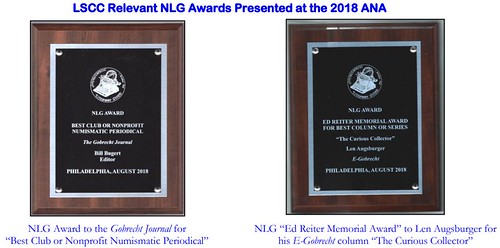
The Numismatic Literary Guild (NLG) chose The Gobrecht Journal edited by Bill Bugert as Best Club or Nonprofit Numismatic Periodical, and Len Augsburger's "The Curious Collector" column in The E-Gobrecht for the Ed Reiter Memorial Award for Best Column or Series. Congratulations! Len Augsburger was also inducted into LSCC's Hall of Fame. Congratulations to all! At right is Len (on right) receiving his award from LSCC President Gerry Fortin (at left). -Editor
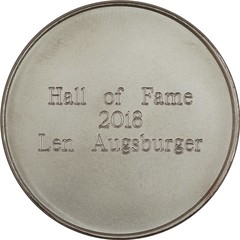

For more information about the Liberty Seated Collectors Club, see:
http://www.lsccweb.org
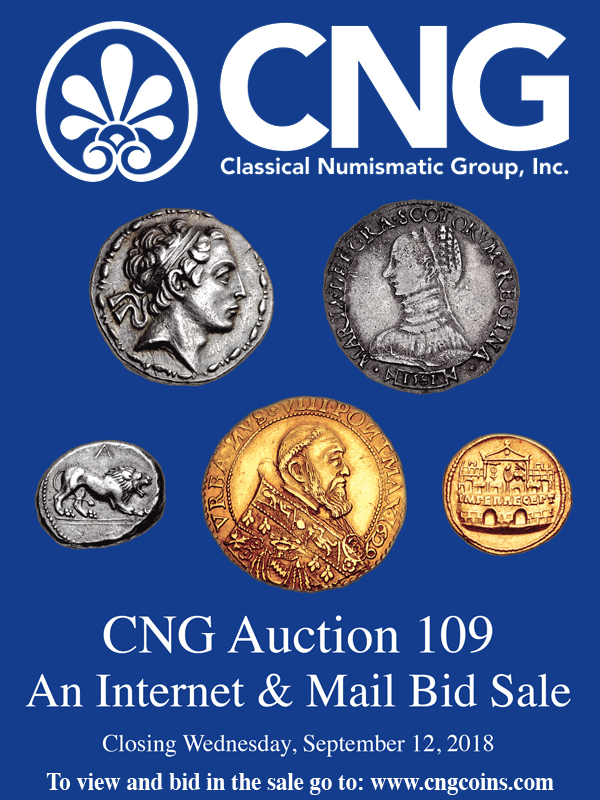
MINT SEEKS ARTISTIC INFUSION PROGRAM APPLICANTS
In a press release this week, the U.S. Mint put out a call for artists to join its Artistic Infusion Program. This is a great opportunity for artists to put their work before millions of citizens and collectors in the longest-lasting format known to man. Pass the word to the talented people in your circle. The application deadline is October 29, 2018. -Editor
 The United States Mint is pleased to announce a call for artists to participate in its Artistic Infusion Program (AIP). Established in 2003, the AIP serves to enrich and
invigorate the design of United States coins and medals by developing a pool of outside artists in graphic design, sculpture, engraving, drawing, painting, and other visual arts.
These artists work closely with the United States Mint’s staff, including Sculptor-Engravers, to create and submit new designs for selected coin and medal programs throughout the
year. Interested artists are invited to submit applications for consideration.
The United States Mint is pleased to announce a call for artists to participate in its Artistic Infusion Program (AIP). Established in 2003, the AIP serves to enrich and
invigorate the design of United States coins and medals by developing a pool of outside artists in graphic design, sculpture, engraving, drawing, painting, and other visual arts.
These artists work closely with the United States Mint’s staff, including Sculptor-Engravers, to create and submit new designs for selected coin and medal programs throughout the
year. Interested artists are invited to submit applications for consideration.
The designs of AIP artists adorn many United States coins and medals, such as America the Beautiful Quarters® Coins, Native American $1 Coins, Commemorative Coins, Platinum Proof Coins, Congressional Gold Medals, American Liberty Gold Coins, and various silver and bronze medals.
Artists who join the AIP work under a task order contract from their own studios across America, providing candidate designs in the form of finished drawings. Artists are paid $2,000 to $3,000 per assignment and are awarded a $5,000 bonus if the Secretary of the Treasury selects their design for a coin or medal. In addition to the bonus, the artist’s information is included in historical documents, Certificates of Authenticity, and promotional materials. In most cases, the artist’s initials appear on the final coins or medals along with the initials of the Sculptor-Engraver who sculpted the selected design.
The United States Mint will be accepting applications for the program beginning September 3, 2018. Applicants must fill out an application form and submit five to 10 images of work from their portfolio. Artists may also be asked to provide a resume. Once reviewed, the Mint will invite selected artists to participate in a further evaluation round, which will require the development and submission of a demonstration design for which each selected artist will be paid a fee of $1,500.
The Mint is especially interested in artists who will bring innovative perspectives and utilize symbolism in their work to clearly and evocatively convey subjects and themes. From portraits and landscapes to depictions of notable achievements in American history, coin and medal designs require rendering a range of subjects and themes on a small space.

Here's an Artnet News article forwarded by Alan Luedeking. Thanks. -Editor
The United States Mint has issued an open call for artists to design the nation’s coins and medals as part of its its Artistic Infusion Program. The government is particularly interested in artists who will “bring innovative perspectives and utilize symbolism in their work to clearly and evocatively convey subjects and themes,” according to the program’s press release.
Who will judge the submissions? None other than Treasury Secretary Steven Mnuchin, a former hedge-fund mogul and son of Manhattan art dealer Robert Mnuchin. Steven was also previously a board member at the Los Angeles Museum of Contemporary Art, but stepped down after seven years to accept President Trump’s nomination to the treasury post.
To read the complete article, see:
Show Him the Money: Treasury Secretary Steven Mnuchin Is Judging an Open Call for
Artist-Designed Coins (https://news.artnet.com/art-world/steven-mnuchin-judges-artists-designed-coins-1338767)
To read the complete press release, see:
United States Mint Announces Call for Artists
(https://www.usmint.gov/news/press-releases/united-states-mint-announces-call-for-artists)
For additional information, see: CALL FOR ARTISTS (https://www.usmint.gov/learn/artists/call-for-artists)
2019 AMERICAN LEGION COMMEMORATIVE COIN DESIGNS
For examples of the contributions of the Artistic Infusion Program, look no further than the recently announced designs of the American Legion commemoratives. Here's the U.S. Mint's press release with additional information gleaned from the Mint web site. -Editor
The American Legion was founded March 15, 1919, in Paris, France, out of concern for the welfare of soldiers and the communities they returned to in the United States after World War I. The non-partisan organization is the nation’s largest veterans group, with nearly two million members in more than 12,000 posts throughout the United States. Membership is open to men and women alike, regardless of ethnic background or religious affiliation.
The Legion focuses its efforts in four areas: Veterans Affairs and Rehabilitation, Children and Youth, National Security, and Americanism. These areas are known as “the Four Pillars” of American Legion service. Throughout its years of service to the nation, it has been a catalyst for social change and it has recorded myriad accomplishments. The Legion’s advocacy on behalf of veterans has been instrumental in the passage of numerous legislation including the Servicemen’s Readjustment Act of 1944, better known as the GI Bill, and multiple legislation to advance government recognition and promote effective treatment of service-connected conditions.
The Legion has awarded millions of dollars in Child Welfare Foundation grants and college scholarships, and has implemented numerous programs and services to assist veterans, their families, and the community.
About the Coins
The American Legion 100th Anniversary Commemorative Coin Act (Public Law 115–65) authorizes the United States Mint to strike and issue up to:
50,000 $5 Gold Coins
400,000 Silver Dollar Coins
750,000 Clad Half Dollar Coins
Recipient Organization
Coin prices include surcharges of $35 for each $5 gold coin, $10 for each silver dollar coin and $5 for each half dollar coin. The Public Law authorizes the Mint to pay the
surcharges to The American Legion to support the Legion’s programs for veterans, members of the Armed Forces, and other purposes specified by the authorizing legislation.
To read the complete press release, see:
American Legion 100th Anniversary Commemorative Coin
Program (https://www.usmint.gov/learn/coin-and-medal-programs/commemorative-coins/american-legion-100th-anniversary)
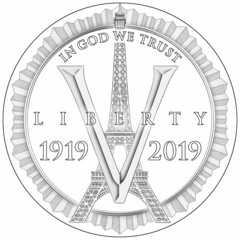

The obverse (heads) design commemorates the inception of the American Legion and its mission to serve America and its war veterans. The outer geometric rim design from the American Legion emblem, the Eiffel Tower, and V for victory, represent the formation of the organization in Paris in 1919 at the end of World War I.
The reverse (tails) design depicts a soaring eagle, a symbol of the United States during times of war and peace alike. The American Legion emblem is depicted above the eagle.
Obverse
Sculptor: Phebe Hemphill, Sculptor-Engraver
Designer: Chris Costello, Artistic Infusion Program
Reverse
Sculptor: Joseph Menna, Sculptor-Engraver
Designer: Paul C. Balan, Artistic Infusion Program
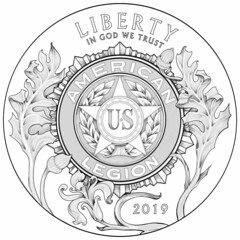
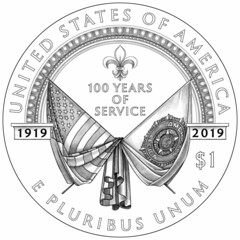
The obverse (heads) design depicts the American Legion emblem adorned by oak leaves and a lily, commemorating the founding of the American Legion in Paris, France.
The reverse (tails) design depicts represents the founding of the American Legion in Paris in 1919. Above the crossed American and American Legion flags is a fleur de lis and the inscription “100 Years of Service.”
Obverse
Sculptor: Renata Gordon, Sculptor-Engraver
Designer: Paul C. Balan, Artistic Infusion Program
Reverse
Sculptor: Michael Gaudioso, Sculptor-Engraver
Designer: Patricia Lucas-Morris, Artistic Infusion Program
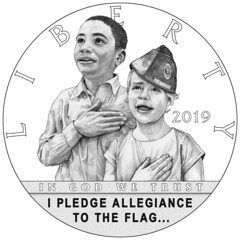

The obverse (heads) design depicts two children standing and reciting the Pledge of Allegiance, the little girl proudly wearing her grandfather’s old American Legion hat.
The reverse (tails) design completes the phrase from the obverse “I pledge allegiance to the flag… of the United States of America.” The design depicts an American Flag waving atop a high flagpole as seen from the children’s point-of-view from the ground below. The American Legion’s emblem is featured just above the flag.
Obverse
Sculptor: Phebe Hemphill, Sculptor-Engraver
Designer: Richard Masters, Artistic Infusion Program
Reverse
Sculptor: Joseph Menna, Sculptor-Engraver
Designer: Richard Masters, Artistic Infusion Program
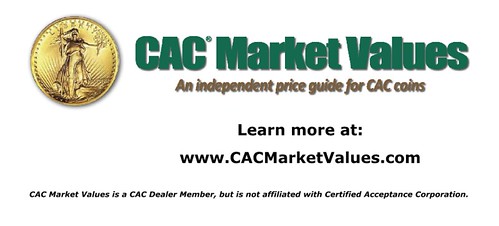
U.S. MINT AND BEP JOIN MARKETING FORCES
It may take some time to see how this develops, but the U.S. Mint and Bureau of Engraving and Printing are teaming up to consolidate the marketing of their products on a single commerce platform. Here's the press release. -Editor
The Bureau of Engraving and Printing (BEP) and the United States Mint (Mint) have formed a strategic alliance to sell BEP numismatic products through the Mint’s e-commerce system beginning this fall. This collaboration will offer collectors, gift-givers, and other customers a better experience and greater variety of numismatic coin and currency products.
Effective Monday, October 1, 2018, BEP products will be available for online purchase only through the Mint’s online store at https://catalog.usmint.gov or by calling 1-800-USA-MINT (872-6468). Hearing and speech impaired customers with TTY equipment may order by calling 1-888-321-MINT (6468). BEP products will still be available at the BEP visitor center gift shops in Washington, DC and Ft. Worth, Texas, and select BEP products will be available at Mint retail locations in Washington, DC; Philadelphia, PA; and Denver, CO. BEP bulk sales customers should continue to place orders through the BEP at 1-800-456-3408.
Please note that BEP online customer accounts will not be automatically transferred to the Mint. BEP customers are encouraged to set up new accounts on the Mint’s website to take advantage of the Mint’s enrollment program, to track purchases of BEP products, and to receive BEP and Mint product and promotion notifications.
As of Monday, September 17, 2018, the BEP will no longer accept orders through BEP’s online store, https://moneyfactorystore.gov, nor its telephone sales department in preparation for the transition. Messaging to that effect will be posted. Beginning October 1 at 8:00 a.m. (ET), the moneyfactorystore.gov website will no longer be accessible, and BEP will redirect online and social media sales traffic to the Mint’s website.
The BEP and Mint are very excited about this new partnership and look forward to providing their global customers with a unique selection of products and continued excellence in customer service.
The Bureau of Engraving and Printing and the United States Mint – Connecting America through Coins and Currency
I like the tag line. While this is probably a good thing for the marketing of collector products, the move will likely only further muddy the public's challenged understanding of the difference between the U.S. Mint and the Bureau of Engraving and Printing. Too many people already think "The Mint" makes paper money. -Editor
To read the complete article, see:
Bureau of
Engraving and Printing and United States Mint Merge E-Commerce Solutions for Better Customer Experience
(https://www.usmint.gov/news/press-releases/bureau-of-engraving-and-printing-and-united-states-mint-merge-e-commerce-solutions-for-better-customer-experience)

THE 50 STATE QUARTERS PROGRAM
This week Lou Golino published a nice analysis of the U.S. Mint's 50 State Quarters Program on CoinWeek. Here's a short excerpt - be sure to read the complete article online. -Editor
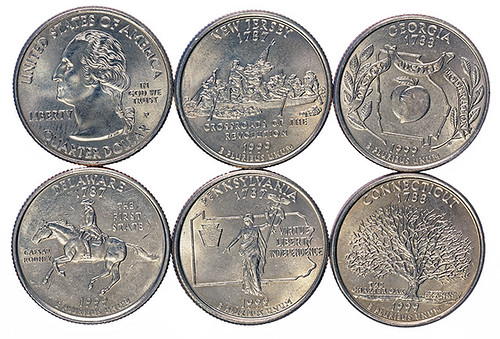
Looking back, the state quarter series played an important role in reshaping American numismatics by reinvigorating interest in collecting coins from circulation, which in many cases led those who did so to collect other coins as well.
In addition, while many of the designs of the state quarters have been described as lacking in artistic merit, the series was a success because collectors were so tired of seeing dead presidents in their change, and the public embraced the new designs. Critics have said many of the designs were too simple or lacked dimensionality, but defenders would respond that they were intended as narrative art, not as miniature masterpieces, and that only so much detail is appropriate for a small canvas.
Overall, the series undoubtedly helped reinvigorate modern U.S. coin design. There are some great designs too such as the Nevada quarter showing several mustang horses running, designed by former Mint sculptor-engraver Don Everhart, and others.
To read the complete article, see:
The Coin Analyst: The 50 State Quarters Program 20 Years Later
(https://coinweek.com/modern-coins/the-coin-analyst-the-50-state-quarters-program-20-years-later/)

MEDAL SELECTIONS FROM NUMISMAGRAM: SEPTEMBER 2018
Jeremy Bostwick of Numismagram forwarded along these three pieces of medallic art from his most recent upload of new material for September. In this listing, he has begun to expand his offerings, now presenting twenty interesting items for consideration. Of note in this artistic array are some pleasing architectural types and a group of lustrous marriage medals from pre-WWI Germany. Visit numismagram.com/inventory to view all of them. -Editor
Ernst August and Viktoria Luise Marriage Medal
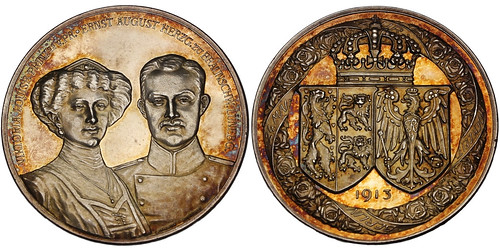
100363 | GERMANY. Braunschweig (Brunswick). Ernst August with Viktoria Luise silver Medal. Dated 1913. Commemorating the Royal Marriage (33mm, 17.85 g, 12h). By L. C. Lauer in Nürnberg.
VIKTORIA LOUISE PRINZss v PR • ERNST AUGUST HERZG zu BRAUNSCHW LÜNEBG, facing busts of Viktoria Luise and Ernst August / Two crowned coats-of-arms within wreath of roses. Edge: SILBER 990.
Brockmann 580; Fiala 5954. Choice Proof. Deeply toned near the peripheries, exceedingly lustrous and brilliant, though with a fair degree of hairlines.
The marriage of Ernst August and Viktoria Luise, which took place on 24 May 1913, was a gallant affair with over 1,000 guests in attendance. Given the union's political importance (it ended the long-standing rift between the Houses of Hannover and Hohenzollern) and familial connections (Ernst August was, on his paternal side, the great-grandson of another Ernst August, the fifth son of Great Britain's King George III, and, on his maternal side, the grandson of King Christian IX of Denmark, the "father-in-law" of Europe––while Viktoria Luise was, on her paternal side, the daughter of the German Emperor Wilhelm II and the great-granddaughter of Great Britain's Queen Victoria), it served as an important and momentous European gathering.
Noteworthy guests were Wilhelm's cousins––Great Britain's King George V and wife Mary, along with Russia's Czar Nicholai II and wife Alexandra. The wedding represented the largest gathering of reigning monarchs in Germany since her unification in 1871, and one of the final grand events before Europe, and much of the world, would be plunged into the chaos of World War I little over a year later.
A marriage medal is a great way to open this listing - on August 18th Jeremy got married. Congratulations and best of luck to him and his new bride! -Editor
To read the complete item description, see:
100363 | GERMANY. Brunswick. Ernst August with Viktoria Luise silver Medal.
(https://www.numismagram.com/product-page/100363)
Le Cynocéphale Plaque

100381 | FRANCE. Bronze Plaque. Issued 1906. "Le Cynocéphale" (60x53mm, 88.57 g, 12h). By P. Jouve in Paris.
Simian cynocephalus (dog-headed monkey) seated left, holding ushabti (Egyptian funerary figurine) / Four monkeys seated left and facing upon tree branch. Edge: «hallmark» BRONZE «hallmark» 134.
Maier 37. Choice Mint State. Pleasing yellow-brown surfaces, with a delightful matte appearance; a few light spots on the reverse. Very rare and extremely interesting. Compare to a similar example in iNumis (3 May 2018), lot 202 (which realized a hammer of €820 [plus buyer's fee]).
A characteristic which has existed in various mythologies and art forms since antiquity, cynocephaly comes from the Greek ???? (dog) and ?efa?? (head). Some deities in the Egyptian pantheon were represented with the heads of jackals and, in Christianity, St. Christopher was oft-depicted as such, while Paul the Deacon refers to the phenomenon in his Historia gentis Langobardorum.
Paul Jouve, having created the sculpture which inspired this plaque, added to this tapestry with an interesting arrangement featuring a dog-headed monkey holding a relic of the past, an Egyptian figurine, also dog-headed, blending the past with the present. The holder of the relic possesses a near-human level of contemplation as it considers this similar-looking ancient object. On the reverse, though the monkeys feature no cross-species characteristics, the iconic "see no evil, hear no evil, speak no evil," a decidedly anthropomorphic trait, can definitely be felt.
I like this - great item. I can't wait to work the phrase "simian cynocephalus" into conversation at the office this week. -Editor
To read the complete item description, see:
100381 | FRANCE. "Le Cynocéphale" bronze Plaque (https://www.numismagram.com/product-page/100381)
Andrées Polar Expedition Medal
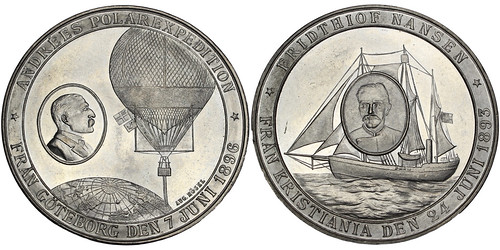
100400 | SWEDEN & NORWAY. Salomon August Andrée & Fridtjof Nansen white metal Medal. Issued 1897. The Scandinavian Polar Expeditions (50, 53.45 g, 12h). By A. Högel in Stockholm.
ANDRÉES POLAR EXPEDITION / FRÅN GÖTEBORG DEN 7 JUNI 1896, hot air balloon Örnen flying over representation of the earth, centered upon the North Pole; to upper left, bust of Andrée right within oval medallion / FRIDTHIOF NANSEN / FRÅN KRISTIANIA DEN 24 JUNI 1893, the Fram under sail left upon the ocean; at center, bust of Nansen facing slightly left within oval medallion. Edge: Plain.
Malpas 156. Choice Mint State. Exceedingly lustrous and brilliant, with a few scattered marks. Great aviation and nautical type.
In 1897, S. A. Andrée led a hydrogen balloon expedition which was intended to see its explorers go from Svalbard (a Norwegian archipelago situated halfway between Norway and the North Pole) to either Canada or Russia, passing over the geographic North Pole in the process. The trip was ill-fated, however, and the balloon crashed only a few days into its journey. While the crew was uninjured, it was left deserted on the uninhabited ice cap island of Kvitøya as winter was approaching. Photographs taken by the crew were eventually developed when their exposed film and belongings were discovered decades later, the mystery of their fate finally being answered.
Equally as challenging, Fridtjof Nansen had been pondering an expedition to the North Pole since the early 1880's. After observing wreckage from a ship wash up near Greenland (on the opposite side of the Arctic whence it had gone asunder), the theory was made that there was, in fact, an ocean current even near pole. Nansen believed that he could sail northward until pack ice was encountered, at which point the engines would be powered down and rudder raised, allowing the vessel to be frozen with the ice, drifting along with the Arctic current and hopefully across the North Pole. The theory was correct, but very unpredictable, and Nansen made the calculation that the crew would not endure the lengthened time of the journey (five years had been planned). Nansen and Hjalmar Johansen then broke away and attempted to pursue their polar destination through dog sledding. Though they were able to get further north than anyone prior in recorded history (86°13.6'N), Nansen again made the calculation that supplies would not allow a completion, and they began their retreat, ultimately rejoining their crew nearly a year-and-a-half after parting ways with them while the Fram was still stuck in ice.
Balloon medals are a great collecting specialty, and combined with a hazardous polar journey this piece has a great story. -Editor
To read the complete item description, see:
100400 | SWEDEN & NORWAY. Andrée & Nansen white metal Medal. (https://www.numismagram.com/product-page/100400)
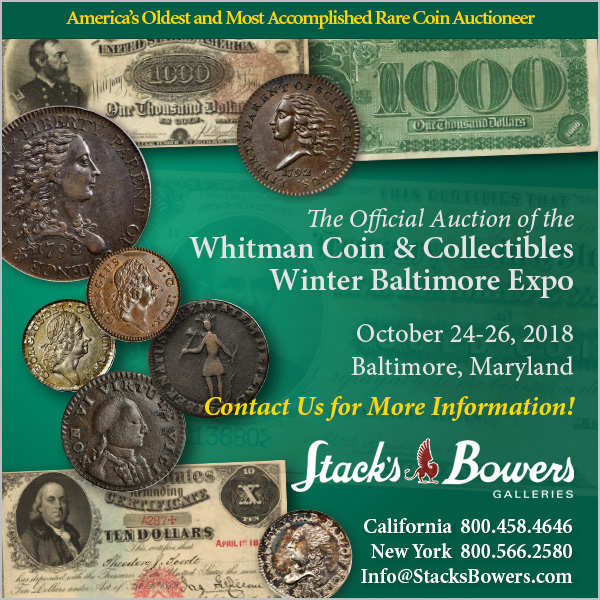
NUMISMATIC NUGGETS: SEPTEMBER 2, 2018
Here's a selection of interesting or unusual items I came across in the marketplace this week. Tell us what you think of some of these. -Editor
Constantine I Follis
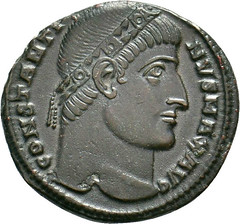
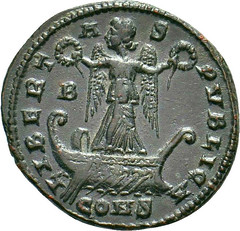
Constantine I (AD 307-337). AE Follis, Constantinople. Obv: CONSTANTINVS MAX AVG, Laureate head right. Rev: LIBERTAS PVBLICA / B / CONS, Victory standing facing on galley, head left, holding wreath in each hand.
Unusual cartoonish-looking figure on the reverse. That head is just not right. -Editor
To read the complete lot description, see:
Roman Empire - AE Follis, Constantine I (AD 307-337).
Constantinople. - Bronze (https://auction.catawiki.com/kavels/20680693-roman
-empire-ae-follis-constantine-i-ad-307-337-constantinople-bronze)
Observationes et Conjecturæ in Numismata Quædam Antiqua
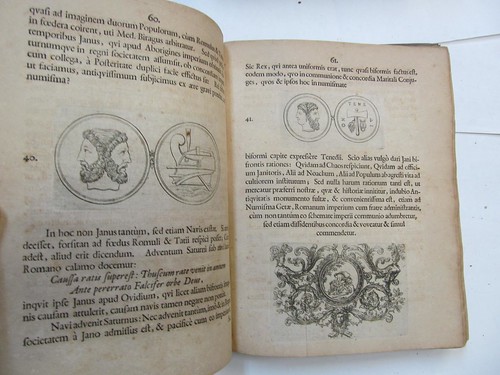
Lorenz Beger, Observationes et Conjecturæ in Numismata Quædam Antiqua. Coloniae Brandenburgicae . MDCXCI. Engraved medals and illustrations within text on most pages. [24], 61, blank, [126], [24] pages. quarto, contemporary vellum; browned, lacking one blank, manuscript note tipped onto leaf in second section. Collation is quite complex.
Nice antiquarian numismatic book from a Connecticut seller on ABEBooks. -Editor
To read the complete lot description, see:
Observationes et Conjecturæ in Numismata Quædam Antiqua
(https://www.abebooks.com/servlet/BookDetailsPL?bi=30038532831)
1796 Quarter
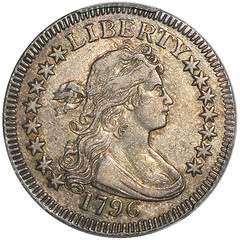
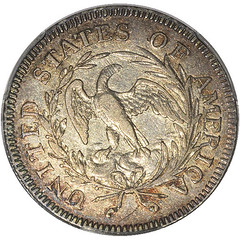
Sharp first year Quarter is an important coin for all serious silver collectors. This one well made with large, bold denticles and light golden reddish color highlighting the devices. These have actually gotten a little cheaper in the last few years, making them an excellent value play for significant blue chip key date first year early type put away for a rainy day coin.
I spotted this great early quarter in the stock of E-Sylum supporter Harry Laibstain. Nice, pleasing coin. -Editor
To read the complete lot description, see:
1796 25C PCGS AU53 (http://hlrc.com/Inventory/CoinViewer?id=868816014&c=23)
Pigeon Award Medal
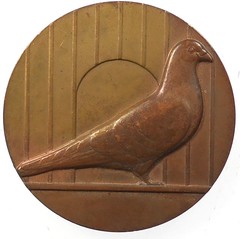
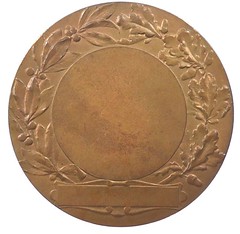
France PIGEON AWARD copper 50mm by Briquemont
Dogs and horses are popular medal subjects. Pigeons? Not so much. I like the spare design of this unawarded medal. -Editor
To read the complete lot description, see:
France PIGEON AWARD copper 50mm by Briquemont (https://www.ebay.com/i/163152240866)
Ronald Reagan Medal Of Merit
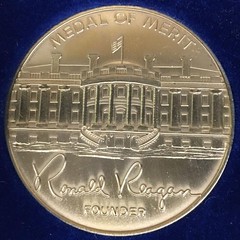
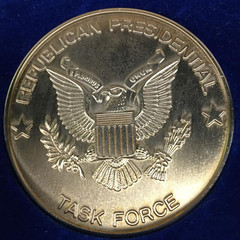
Ronald Reagan (1911 - 2004)
Lot 417: Ronald Reagan Medal Of Merit
Description: 2" Diameter. In Case.
We've discussed various types of Presidential medals in the past, but I don't believe I've seen this one. Not an official government issue - common, but interesting. I don't see any designer initials and wonder who designed and made this. -Editor
To read the complete lot description, see:
Lot 417: Ronald Reagan Medal Of Merit (https://www.invaluable.com/auction-lot/-1-c-A4C4509955)
I found another in the stock of Lori Ferber Presidential Memorabilia. -Editor
This is the original Medal of Merit presented by Ronald Reagan and the Republican National Committee to contributors to the Republican party. In the original box.
To read the complete lot description, see:
Ronald
Reagan Medal of Merit in Original Box (https://www.loriferber.com/ronald-reagan-medal-of-merit
-in-box.html?gclid=CjwKCAjw8ajcBRBSEiwAsSky_X-KfXvU8Fw6Y8r5sL
dwRF5bffAfRs14TsJf7G4BaPewyoVeTOvwIBoC5a4QAvD_BwE)
Salvador Dali Medals for Calgary Olympic Games
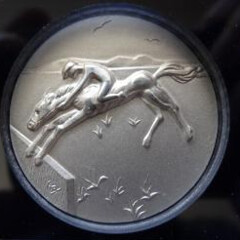

Casket containing 5 silver medals (999.9). Diameter 3cm
Representing :
- Horse riding and jumping
- Archery
- Pole vault
- Swimming
- Memorial medal celebrating the Americano-Canadian frenship during the Calgary 88 Olympic games.
We've discussed Salvador Dali medals before, but I don't think I've seen these. I like the abstract forms, almost like robots. -Editor
To read the complete lot description, see:
Salvador DALI Casket containing 5 commemorative
silver medals. (https://www.lotprive.com/en/buy/post-war-modern-art/salvador-dali-casket-containing-5-commemorative-silver-medals-299276)
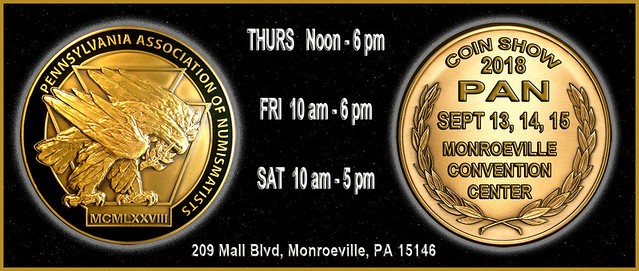
MORMON MONEY IN KAGIN'S SEPTEMBER 2018 SALE
This press release covers highlights of the upcoming Kagin's West Coast sale. -Editor
Mormon Coins and Currency, SSCA Gold Ingot Highlight Kagin’s West Coast Auction
An offering of forty lots of popular Mormon gold, copper and Paper Currency is one of the features of Kagin’s West Coast Auction held in conjunction with the Santa Clara Expo, September 21 at the Santa Clara, Ca. Convention Center. The LDS Mormon Collection of gold coins includes high grade specimens of an elusive 1849 $2 ½ NGC AU-58, the 1849 $5 in PCGS AU-58 and an NGC AU-58 1850 $5. These are followed by four different varieties of the 1897 Mormon Commemorative Restrikes struck from the original dies-- two of which are finest known.
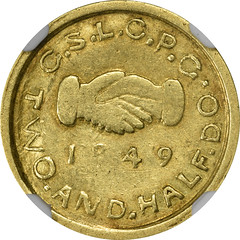
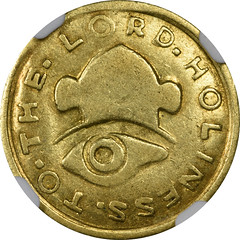
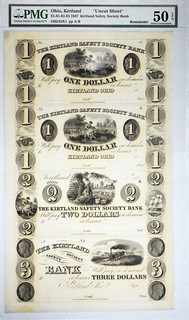 The Mormon currency in the collection is among the finest offering of this series ever! A very rare uncut sheet of four Kirtland Safety Society Bank notes graded AU-50
EPQ is the finer of just two sheets certified by PMG. The individual Kirtland Notes include Finest Known Gem CU-65 $5 and $10 specimens as well as some of the finest $20, $50 and
$100 denominations. There are also three “Anti-Banking” notes and two high grade “Countersigned” $5 and $10 notes hand signed by both Joseph Smith and Brigham Young. The latter is
tied for the second finest certified. Other notes include rare Bank of Monroe notes signed by Oliver Cowdery, a set of the 1849 “White or Valley Notes” including three which are
the finest certified, a rare Deseret Currency Association note and a Deseret National Bank Note signed by Joseph Smith.
The Mormon currency in the collection is among the finest offering of this series ever! A very rare uncut sheet of four Kirtland Safety Society Bank notes graded AU-50
EPQ is the finer of just two sheets certified by PMG. The individual Kirtland Notes include Finest Known Gem CU-65 $5 and $10 specimens as well as some of the finest $20, $50 and
$100 denominations. There are also three “Anti-Banking” notes and two high grade “Countersigned” $5 and $10 notes hand signed by both Joseph Smith and Brigham Young. The latter is
tied for the second finest certified. Other notes include rare Bank of Monroe notes signed by Oliver Cowdery, a set of the 1849 “White or Valley Notes” including three which are
the finest certified, a rare Deseret Currency Association note and a Deseret National Bank Note signed by Joseph Smith.
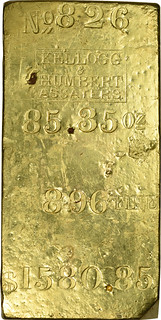 Another highlight of the sale is a hefty 85.35 Ounce Kellogg & Humbert gold ingot recovered from the most valuable numismatic shipwreck, the S.S. Central America. The
gold content alone approaches six-figures. Additional Gold Rush financial documents, nuggets and ancillary material are part of this sale.
Another highlight of the sale is a hefty 85.35 Ounce Kellogg & Humbert gold ingot recovered from the most valuable numismatic shipwreck, the S.S. Central America. The
gold content alone approaches six-figures. Additional Gold Rush financial documents, nuggets and ancillary material are part of this sale.
Besides Colonial and Federal copper, silver, gold and commemorative coins, there is a selection of Pioneer and California Fractional Gold and artifacts.
Specialized collections include a So-called Dollar collection of Pan Pacific coins and Columbian World’s Fair Match safes as well as other tokens, medals, Exonumia and Hawaiiana.
Of particular interest to Northern California collectors, historians and currency enthusiasts is one of the finer Emperor Norton I notes listed in The 100 Greatest American Currency Notes.
Additional banknotes include federal and fractional currency, errors and Confederate currency.
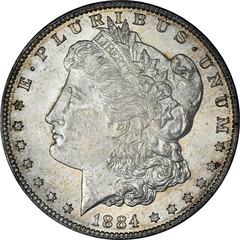
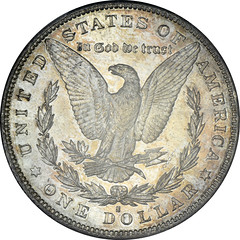
for more information, see:
https://www.kagins.com/

EMPEROR NORTON BOND IN KAGIN'S SALE
This press release discusses the rare Emperor Norton I bond in the September 2018 Kagin's West Coast sale. -Editor
San Francisco’s Own Emperor Norton I Featured in Kagin’s West Coast Auction
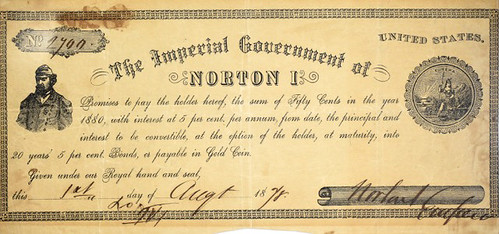
One of the finest examples of the famous “Emperor Norton I” bond or banknote is being offered for sale Friday, September 21, by Kagin’s Auctions in conjunction with the Santa Clara Expo Coin and Stamp show held at the Santa Clara Convention Center. The 50 Cent Bond, dated August 1, 1878 is just one of less than 40 known. It is estimated to bring $15,000-$25,000.
There are few historical figures more intriguing or beloved than that of Joshua Norton, the prominent 19th century business man turned eminent eccentric, and our nation’s first “Emperor” Presiding over San Francisco in the years following the Gold Rush, Norton is today known best by his self-assumed title as Norton I, Emperor of the United States and Protector of Mexico.
The Early History of Joshua Abraham Norton
Born in London in the aftermath of the French revolution and Napoleonic Wars, the infant Joshua Abraham Norton (1818-1880) relocated with his family to Cape Town, South Africa in 1820. With the execution of Louis XVI and other members of the French royal family during the revolution, rumors of missing heirs to the French throne were common. In a particular mental quirk, the young boy grew up believing he was one, hidden for safety within a Jewish family. Years later, in 1886, Norton revealed this long-kept “secret” to a South African friend in San Francisco. Norton told him that he was “a crown prince to the throne of France.” In memory of his not-so-humble origins, Norton carried a silver 1828 Bourbon franc till his dying day.
An undistinguished stint as a shopkeeper and the death of his father inspired Joshua Norton to use his inheritance to build a fortune elsewhere than South Africa. He caught gold fever and arrived in San Francisco in November 1849, where he promptly became a commission merchant. He could judge the market for goods when ships arrived from varied cargoes, sought out buyers, and sold the merchandise for a percentage of the sale price.
Norton’s profits went into real estate, and soon he had three of four corners at the intersection of Sansome and Jackson Streets. A rice mill, the first in the city to hull this grain, grew on one; a cigar factory, which turned cheaply-imported tobacco into a saleable product, sprouted on the second; and an office building opened on the third. His water lots – purchased with the hope that encroaching bayfill would make them the city’s new waterfront – in the meantime held the abandoned brig Genesee. As the great sidewheel steamers of the Pacific Mail Steamship Company docked semi-monthly next to this small two-master, Norton wisely made it into a storeship.
Growing wealth and prominence led to Joshua Norton’s participation in civic affairs. In the summer of 1851, noted business leaders formed a Committee of Vigilance to suppress crime. Norton was member #339, but he abhorred summary justice. His persuasiveness and devotion to civil rights convinced the Committee to allow the accused to present a defense.
Emperor Norton I’s Regime
Joshua Norton’s educated demeanor, wealth and business skill made him an esteemed member of San Francisco society. When talk turned to politics, Norton defended the English monarchy and declared, “If I were Emperor of the United States, you would see changes.” His friends quickly dubbed him “Emperor,” but Norton actually was not joking. Later, he decided his reign had begun in 1852.
That year also brought him financial disaster. In December, in an effort to corner the rice market, Norton bid 12.5 cents a pound for a recently arrived cargo of then scarce rice. Within days, inexplicably, ship after ship glutted the market with excess rice, reducing the selling price to 3 cents. Not only did Norton initially lose money, but the business depression of 1854, financial panic of 1855, long legal battles over the rice contract, and avaricious bankers drained his resources entirely. Fewer and fewer commissions came his way, and in 1856, 1857, and 1858, Norton declared bankruptcy.
Obviously depressed, Norton exited from society. He reappeared however on September 17, 1859, apparently reborn, when he delivered a document to the San Francisco Evening Bulletin. Now a self-styled savior for the ills of society, Norton announced “the peremptory request of a large majority of citizens of these United States. I, Joshua Norton…declare and proclaim myself Emperor of these U.S.” Norton called a convention to be held February 1, 1860, in order to “ameliorate the evils under which the country is laboring, and thereby cause confidence to exist, both at home and abroad, in our stability.” From then on, he was Norton I.
“In order to give weight, Precedence and legality to our Orders,” Norton proclaimed on June 10, 1862, “We do hereby Command the Leaders of the Hebrew, Catholic and Protestant Churches to sanctify and have us crowned Emperor of the U.S. of America and Protector of Mexico.”
While one may say he was a bit delusional, he was also quite prescient, suggesting the bridging of San Francisco Bay as well as tunneling underneath it; two ideas which came to fruition long after his death in the building of the San Francisco-Oakland Bay Bridge and the Transbay Tube.
Norton I advocated religious and social tolerance. “Religion is like a beautiful garden,” he declared, as he worked in 1871 for “the establishment of a Universal Religion.” The next year, Norton “Hereby prohibit[ed] the enforcement of the Sunday Law,” since it discriminated against Germans and Jews.
Norton was also an early advocate of racial integration. As the post-Civil War fight for school integration heated up in the mid-1870s, he reasoned, “Whereas the American nation having acknowledged the citizenship of the colored people, their children are entitled to admission in the public schools.”
Norton I’s Royal Treasury Bonds
Though Norton was welcomed by most everyone, the Imperial Treasury remained sparse. Free lunches, gratis transportations, and admission to shows and lectures, coupled with taxation through Imperial bonds, allowed Norton to meet his daily needs. These “Bonds of Empire” are unique. In the 1860’s, when President Abraham Lincoln undertook to circulate greenbacks during the Civil War, Californians disdained them, paying as low as 38 cents in gold for $1 in paper. In contrast, the Emperor was the first to successfully circulate a paper money that found immediate acceptance – with no discount – among gold-loving San Franciscans.
Norton I issued the first note in late June 1869. Between January 1870 and 1876, printers Cuddy & Hughes created three designs for the Emperor’s popular 50-cent bond. All showed the Emperor and paid seven percent interest, collectible in 1880. Some have an inked “seal” most likely made from a coin.
The earliest 50-cent note to survive carries the date November 11, 1870. Printed in bright red, it shows a large Columbia in front of a San Francisco scene. A dog, presumably Norton’s, lies next to a safe.
From 1877 to 1880, Charles A. Murdock was the Emperor’s favorite printer. In the almost ten years of his reign, His Majesty issued over 3000 Bonds of Empire. Today, we know of only thirty-five. There are a total of nine types with various scenes and other denominations including $5, $10 and $100 notes. While retaining the 1860s cut of the Emperor on the left, Murdock added the California State seal to the right. Murdock saved the empire money when he reduced the rate of interest from seven to five percent. When the 1870s bonds matured in January 1880, Murdock and the Emperor solved a possible embarrassment by rolling them over at reduced interest. On the day he died, January 8, 1880, Emperor Norton issued 50-cent bond #3042, payable in 1890, at only 4 percent.
Emperor Norton I was also a mason, a member of the drinking society, e. Clampus Vitus, and nationally beloved. When he died, ten thousand people turned out for his funeral.
Since Norton’s death, his subjects have vastly increased, while 50-cent Imperial bonds bring $15,000--$20,000 on the collector’s market. His Empire was illusionary, but he was not as mad as some thought; Norton’s advocacy for tolerance towards others and religious and racial equality and is a wonderful legacy for our first Emperor.
I'm a big fan of all things Emperor Norton. The lovable lunatic's legacy lives on. -Editor
for more information, see:
https://www.kagins.com/

NORTHEAST SELLS 1943 COPPER CENT
Tom Caldwell of Northeast Numismatics penned this blog post about their recent sale of a 1943 Copper Cent. -Editor
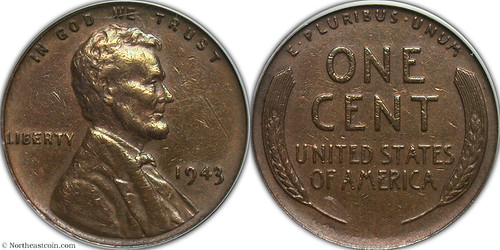
Early last year we acquired a certified 1943 Copper Lincoln Cent in XF condition. This was the first 1943 Copper that I have had the privilege to own and offer in my entire 54-year career. This rarity is among the most desirable and rarest United States coins and it is known among veteran coin collectors and non-collectors alike, as it frequently makes the news.
All coin dealers, ourselves included, receive phone calls and emails on a regular basis from the public with claims that they have a genuine piece. In most cases, simply taking a magnet to the coin will prove that the coin in question is just a copper coated specimen of virtually no value, thereby immediately dashing dreams of riches. Occasionally more sophisticated counterfeits surface that demand more attention to disprove authenticity. With only about 20 known pieces, the chances of finding a genuine piece are, needless to say, astronomically slim.
We enjoyed the pride of ownership of our piece while displaying it at regional and national coin shows, where it garnered a lot of attention and comments from collectors (and dealers!) who had never seen such a piece in person. Some folks even asked to take photos and/or hold the coin, figuring another such opportunity would never arise. We were very happy to oblige.
After offering the 1943 Copper for sale on our site (www.northeastcoin.com) for much of 2017 without a sale, we decided to take it off the market and perhaps bring it out for display again at some later date. While packing for the recent ANA Money Show that was held in Philadelphia, we decided this might be a good opportunity for the collectors in the City of Brotherly Love to view the coin, so we brought it along.
One of the collectors attending the show, Willie (a client of ours whom we see at every ANA), came by the table and expressed interest in the coin, saying he had always dreamed of owning one. We then recalled last year that Willie had mentioned he was anticipating the sale of his restaurant and if it happened to go through he would consider the purchase of our piece.
Well, the timing was right for Willie this year!
As we are always willing to work with clients on a layaway basis for big and small purchases alike, we were able to come to an agreement with him on the 1943 Copper. We are thrilled that our rarity has found a new happy home. Congratulations Willie - sometimes dreams do come true. Enjoy!
It turns out that I just missed seeing this transaction in person. I viewed the coin at the Northeast table, and the buyer was there at the same time, although we didn't get a chance to meet. Chris Clements sent me the photo of the coin. Thanks. -Editor
To read the complete article, see:
1943 Copper Cent - Dreams do come true! (https://www.northeastcoin.com/blog.jsp)
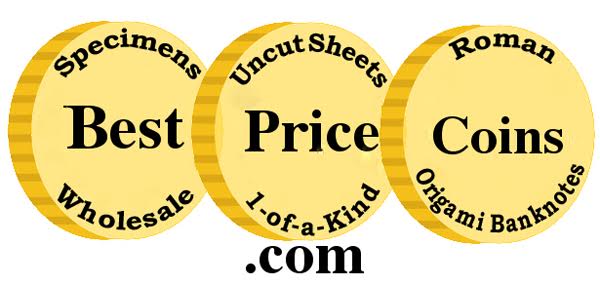
NEW EVERMAN COUNTERSTAMP DISCOVERED
Bill Groom submitted this article on his discovery of a new EVERMAN counterstamp, this time on a gold dollar. Nice! Thanks. -Editor
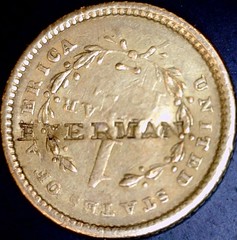
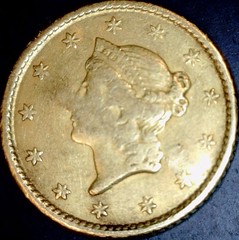
As evidenced by previous E-Sylum postings, there's been some renewed interest in this as yet maverick issue; this, given that there are some gold coins which bear the EVERMAN counterstamp. Some months ago, I reported finding the latest dated host coin bearing this mark, an 1857-O half dollar. As luck would have it, I just acquired an 1851 gold dollar that bears the EVERMAN mark. I believe that this brings the reported count to twelve or so pieces.
The discovery of the 1857 dated host coin suggests to me that Everman's counterstamp may have been applied as late as 1858 or thereabouts. This latest find, dated 1851, doesn't offer any additional clues about the issuer.
It's been suggested that one Lewis Everman, a Tennessee silversmith may be the issuer. As I reside in Tennessee, I'd love that to be the case! Try as I have, I've been unable to locate a single Everman-stamped product, like a spoon or a watch.
This EVERMAN stamp is a retailer's tiny mark; this, as opposed to a silversmith's hallmark set in relief. By the 1850's, many silversmiths found that retailing imported products was time more profitably spent than laboring at their bench. This was especially true in the larger cities like Philadelphia, Boston and New York - then, the three principal cities of counterstamp issue.
Below is a link to Boyd's 1859 Lancaster (Philadelphia) Directory. Listed therein, Charles Everman is not listed in McElroy's Philadelphia directories. He remains my odds-on, principal candidate as issuer of the Everman pieces. The Philadelphia area was THE major hub of counterstamping coins. Charles was a retail jeweler, active in 1858. Philadelphia, being a port city, likely saw coins, like the Humbert $50 gold piece, arriving from California. Prominent Philadelphia collectors of that time would doubtless have paid a premium for that "slug."
I've long considered the collecting of counterstamps to be the "final frontier" of numismatics. There remains ever so much to be discovered and learned about this genre. Counterstamps that have been positively attributed tell us ever so much about the people who marked them; and, the times during which the coins circulated. Personal stories and history lessons typically unfold as anyone who researches this genre can attest.
One last word on the EVERMAN counterstamps .... I'm rooting for Eric Schena, hoping he'll someday prove that Tennessee's Lewis Everman was indeed the issuer!
Eric Schena writes:
What a fantastic piece! I am still on the prowl for some piece of evidence (an ad, a marked example of silverware, etc.). I have an 1854 quarter eagle and an 1858-O half dollar with that mark. I hope something turns up to solve it once and for all.
I collected merchant counterstamps for years, attempting to build a type collection of undertypes. What I learned quickly was the larger the coin, the better to host a counterstamp. Small coins like the three cent nickel or three cent silver were quite hard to find with a counterstamp. I've never seen one on a gold dollar, the tiniest of U.S. coins. Great piece! -Editor
Charles Everman listing in Lancaster County directory:
https://books.google.com/books?id=jvBXAAAAYAAJ&pg=PA79&dq=directory
,+%22Everman%22&hl=en&sa=X&ved=0ahUKEwj0_ePXvJTMAhVFmYMKH
TVkDUEQ6AEIRDAJ#v=onepage&q=directory%2C%20%22Everman%22&f=false
To read the earlier E-Sylum articles, see:
NEW RESEARCH ON THE EVERMAN COUNTERSTAMP (http://www.coinbooks.org/esylum_v18n23a16.html)
MORE RESEARCH ON THE EVERMAN COUNTERSTAMP (http://www.coinbooks.org/esylum_v18n24a15.html)
THE EVERMAN COUNTERSTAMP – A NEW FIND (http://www.coinbooks.org/esylum_v19n17a14.html)
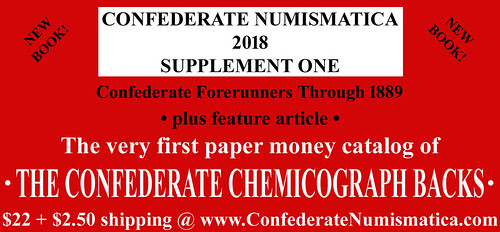
SAUDI BANKNOTES INSPIRED BY HAJJ PILGRIMAGE
The Hajj — Arabic for “pilgrimage” — is a five-day religious pilgrimage to Mecca and nearby holy sites in Saudi Arabia that all Muslims who are physically and financially able must perform at least once in their lives. This article describes how the Hajj inspired the creation of Saudi Arabian banknotes. -Editor
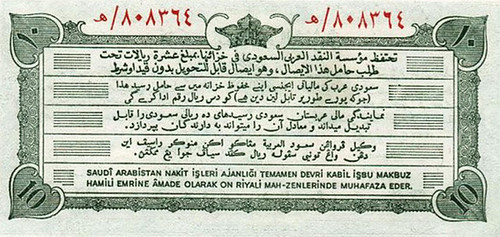
The riyal became the currency of Saudi Arabia since it was founded in 1932. Before that the currency was being used only in the Hijaz region. The first Saudi currency bearing the name of the country, which was smaller and lighter than its predecessor, was minted in silver in 1935.
The Saudi Arabian Monetary Authority (SAMA), the second-oldest central bank in the Arab world, was created in 1952 to develop and unite the Saudi monetary system. Given the fast-paced growth of the economy and increasing revenues, King Abdul Aziz was aware that it was not realistic to continue using metal coins and there was a need for a more practical form of currency. In particular, piles of silver Saudi riyals were a heavy burden for pilgrims to carry with them during Hajj seasons.
In 1953, the king took a courageous decision to issue the first Saudi banknotes. They were known as “pilgrims’ receipts,” each worth 10 silver riyals.
The first batch of 5 million were printed in Arabic, Persian, English, Urdu, Turkish and Malayan. Pilgrims welcomed the new paper currency and it quickly became widely accepted throughout the Kingdom.
Its success encouraged confidence among Saudi traders and citizens. However, pilgrims started to collect the receipts as souvenirs and gifts to take back to their home countries, which prompted the Ministry of Finance and Economy to ban commercial use of them overseas. The acceptance and popularity of the receipts persuaded SAMA to re-issue them in 1954, with the addition of a new 5 riyal denomination, which was followed by 1 riyal pilgrims’ receipt in 1956.
SAMA realized that citizens and pilgrims were happy for the old metal coins to be replaced with the paper notes, so they decided to keep using it after Hajj, rather than returning to the old currency.
In June 1961, Saudi banknotes were issued for the first time, in denominations of 1, 5, 10, 50 and 100 riyals. As a result, the pilgrims’ receipt was phased out in 1965.
Hajj is not only the reason behind the introduction of Saudi banknotes, it has also played an important role in the increasing the value of the currency. As the number of pilgrims coming to Makkah has continued to grow every year, the demand for riyals has increased at banks and local and foreign exchanges; three times as many riyals are purchased during Hajj season than during the rest of the year. This inflates its value and refreshes the market.
The most-exchanged foreign currencies during Hajj are the US dollar, the euro, the Singapore dollar, the Indian rupee, the Indonesian rupiah, the Emirati dirham and the Malaysian ringgit.
Thanks to the August 28, 2018 issue of News & Notes from the Society of Paper Money Collectors (edited by Loren Gatch) for the link to Arab News. Thanks also to the Vox article linked below, where I borrowed my description of the Hajj. Love their subtitle: "It’s like Burning Man, but for Muslims. Okay, it’s nothing like Burning Man." -Editor
To read the complete article, see:
Role of Hajj in the introduction of Saudi banknotes (http://www.arabnews.com/node/1360046/saudi-arabia)
For more information, see:
Hajj (https://en.wikipedia.org/wiki/Hajj)
Hajj, the Islamic pilgrimage to Mecca, explained for non-Muslims
(https://www.vox.com/2016/9/12/12814258/hajj-2018-islamic-pilgrimage-mecca-what-is-explained)

FORMER MEXICAN PRESIDENT ON NEW BANKNOTE
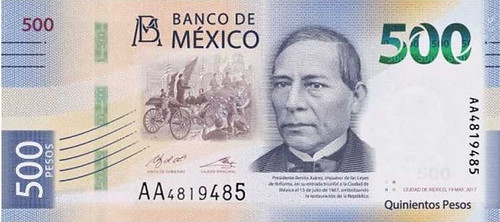
Mexico, Aug 28 (Prensa Latina) The image of Benito Juarez distinguishes the new 500-peso banknote (about $30 USD) the Banco de Mexico is launching here today.
The paper money present improvements in security features, functionality and durability, Alejandro Alegre, general director of Issuance of the Central bank (autonomous), said.
Our historical legacy and natural wealth are reflected, because it illustrates the process of the Reformation and Restoration of the Republic, the Bank of Mexico details.
The image of Juarez, former Mexican president from 1858 to 1872, replaces those of 2010 whose protagonists were artist Diego Rivera, and in the reverse painter Frida Kahlo.
The new banknote has a marine ecosystem as its reverse (Mexico has one of the major marine natural reserves on the planet), with figures of a whale and sperm whale, which are recurring and expected images on the northern Pacific coasts in Mexico.
To facilitate the identification of this banknote, three tactile lines were included in the upper left corner for visually impaired and blind people.
To read the complete article, see:
Benito Juarez' Image on New Mexican Banknote
(https://www.plenglish.com/index.php?o=rn&id=32930&SEO=benito-juarez-image-on-new-mexican-banknote)
See also this Coin Update article by Michael Alexander. -Editor
To read the complete article, see:
Mexico: Introduction of new 500-peso banknote launches new series
(http://news.coinupdate.com/mexico-introduction-of-new-500-peso-banknote-launches-new-series/)

WHY DOES THE DOLLAR BILL LOOK THAT WAY?
This TIME magazine article provides a nice overview of the history of the U.S. dollar bill. Interesting image of an uncut sheet lacking overprinting. -Editor
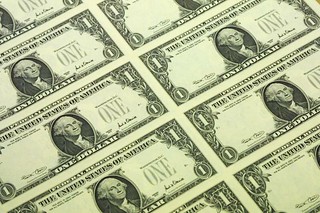 The dollar has been interlaced with American history since the very beginning. It has been trumpeted as the root of all evil, and touted as the salvation of
individualism.
The dollar has been interlaced with American history since the very beginning. It has been trumpeted as the root of all evil, and touted as the salvation of
individualism.
But why does the dollar look the way it does? Though American paper currency has gone through many evolutions, its design has largely been governed by practical concerns.
The article touches on the 1690 Massachusetts Bills of Credit, Continental Currency, the Great Seal, and Confederate currency. -Editor
It wasn’t until 1913 that the Federal Reserve Act created the surviving modern form of currency. The law gave the federal government the authority to issue Federal Reserve Notes (commonly known as U.S. dollars) as legal tender.
But by that point, many of the design elements now recognizable from the American dollar were already set. The rough proportions, the typeface, the intricate borders, the color green, even some of the wording — all of those components were in use before the Federal Reserve Note was born.
The front of these notes usually featured presidents while the back captured iconic Americana. For example, a $5 note from 1914 featured Abraham Lincoln on the front, and the landing of the Pilgrims at Plymouth Rock on the back. The main designs changed little over the years, with a few noteworthy exceptions.
As was the case two centuries earlier, the design of the dollar was primarily — but not exclusively — determined by the desire to prevent counterfeiting, not by aesthetic concerns.
To read the complete article, see:
The American Dollar Bill Looks the Way It Does for a Reason
(http://time.com/5383055/dollar-bill-design-history/)

LOOSE CHANGE: SEPTEMBER 2, 2018
Here are some additional items I came across in the media this week that may be of interest. -Editor
The Onion Goes Numismatic
The satirical publication The Onion has finally gotten around to skewering coin collectors. -Editor
To read the complete article, see:
Coin Collector Has Some Pretty F***ing Nice Coins
(https://local.theonion.com/coin-collector-has-some-pretty-f***ing-nice-coins-1828653096)
India Considers State Digital Currency
The Bank of England previously investigated the creation of its own cybercurrency, ultimately rejecting the idea, at least for the time being. But now India is looking into it. -Editor
India's central bank is researching how to introduce a rupee-backed central bank digital currency (CBDC) into its monetary policy in a bid to reduce its hefty annual bill for minting physical cash.
The news was revealed in the Reserve Bank of India's (RBI) annual report, published Wednesday, which indicated an inter-departmental unit has already been formed within the organization to study the "desirability and feasibility to introduce a central bank digital currency."
To read the complete article, see:
India Eyes State Digital Currency to Cut $90 Million Banknote Bill
(https://www.coindesk.com/india-eyes-state-digital-currency-to-cut-90-million-banknote-bill/)
Moy Speaks At Blockchain Conference
Former U.S. Mint Director Ed Moy spoke at the Voice of Blockchain conference in Chicago last week. -Editor
Speaking Saturday about the future of currency, Edmund Moy, who served as the Mint’s 38th director between 2006 and 2011, praised cryptocurrencies as a free market solution that could bring “unbanked” people around the world out of poverty. He also said cryptocurrencies would disrupt the way governments have traditionally provided fiat currencies in the same the way email affected postal services.
To read the complete article, see:
Ex-Mint Director Cheers Crypto’s Potential to Reach ‘Unbanked’
(https://thirtyk.com/2018/08/27/mint-cryptocurrency-unbanked/)

FEATURED WEB SITE: ELSEWHERE NUMISMATIC SOCIETY
This week's Featured Web Site is the Elsewhere Numismatic Society.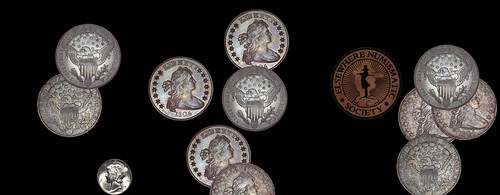
http://elsewherenumismatic.com/

